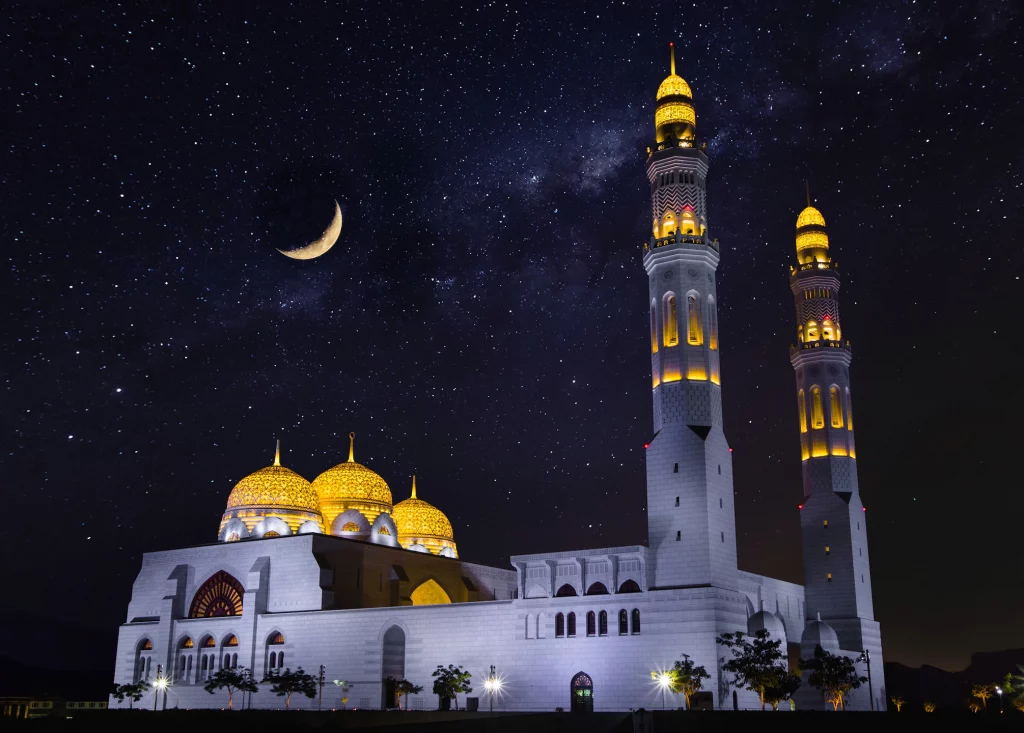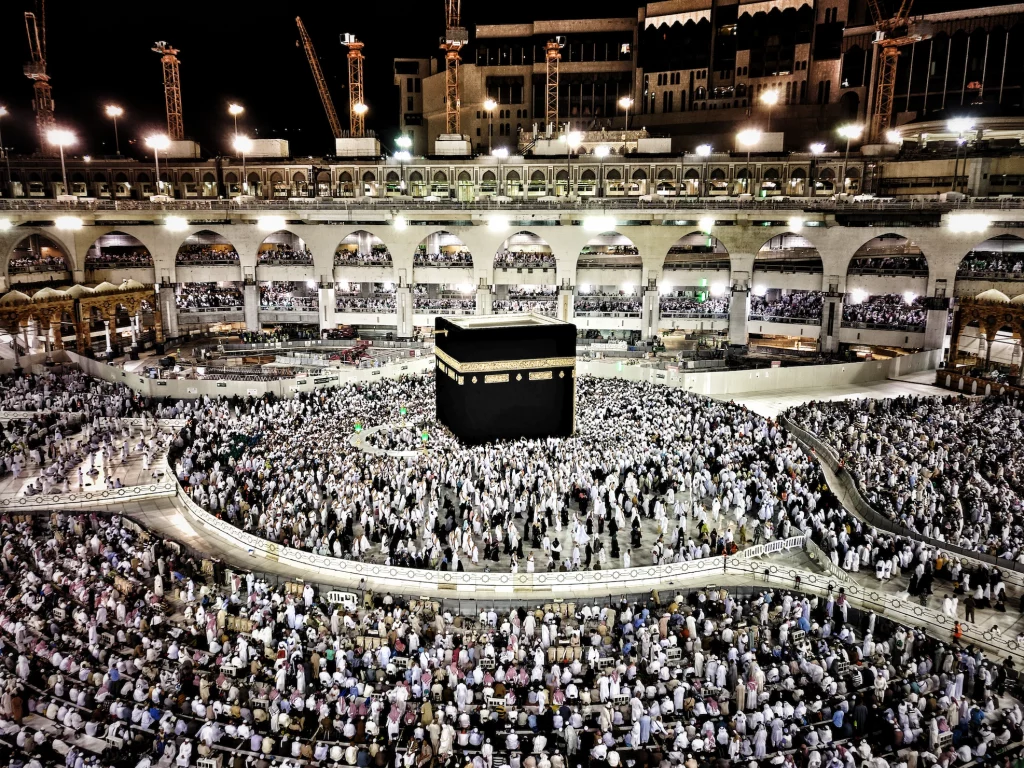
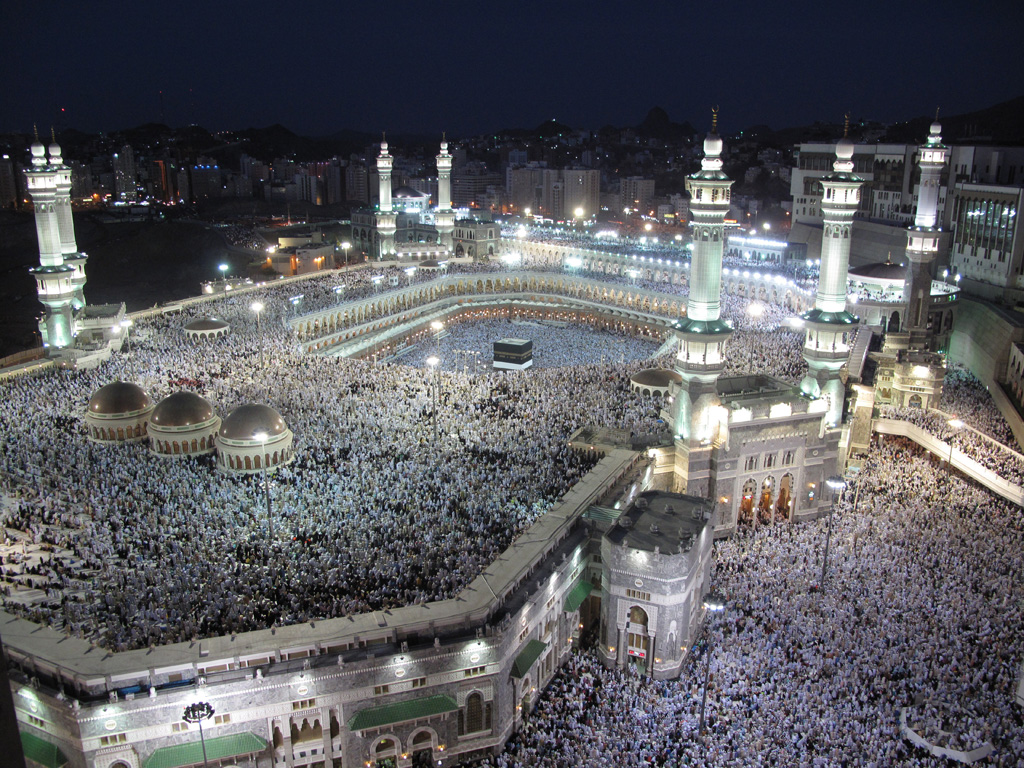
The Kaaba (Arabic: The Cube) is the most sacred site in Islam. It is surrounded by the Masjid al-Haram. During the Hajj period, the mosque is unable to contain the multitude of pilgrims, who pray on the outlining streets. Established by ʾIbrāhīm (Abraham) (pbuh) and has been utilized for centuries before the revelation of the Quran. Before Mecca and Jerusalem came under Muslim control between 630 CE and 638 CE, the site of the Kaaba, which (according to Muslim belief) was established by Ibrahim and Ismail.
And when We assigned to Ibrahim the place of the House, saying: Do not associate with Me aught, and purify My House for those who make the circuit and stand to pray and bow and prostrate themselves. — Quran, Sura 22 (Al-Hajj), ayah 26
And remember Prophet Abraham and Isma’il raised the foundations of the House (With this prayer): “Our Lord!” Accept (this service) from us: For Thou art the All-Hearing, the All-knowing. — Quran, Sura 2 (Al-Baqara), ayah 127
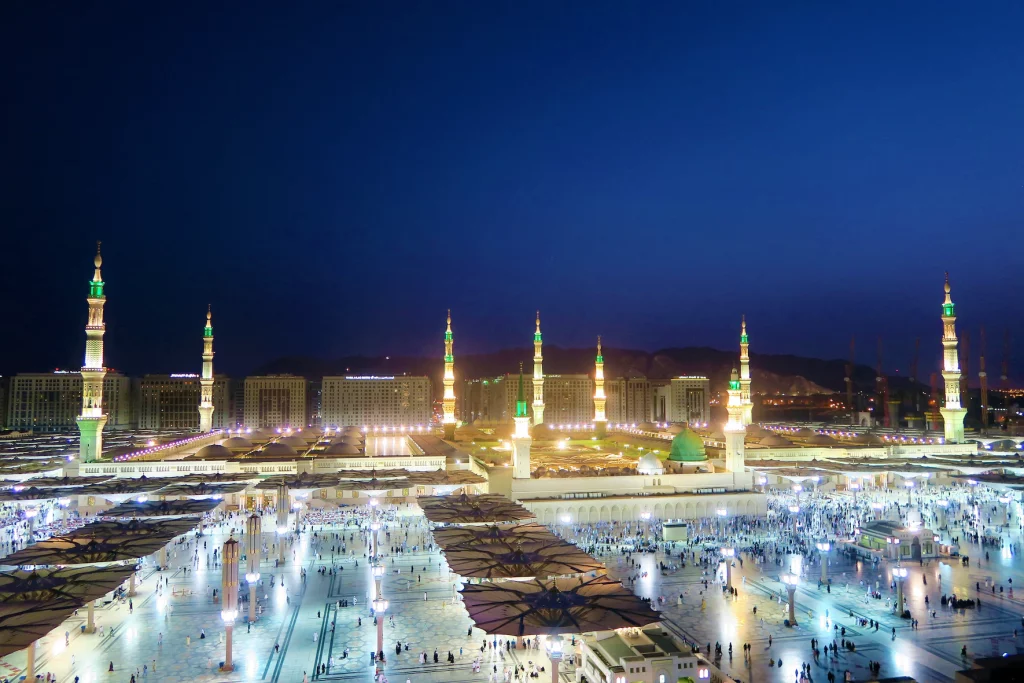
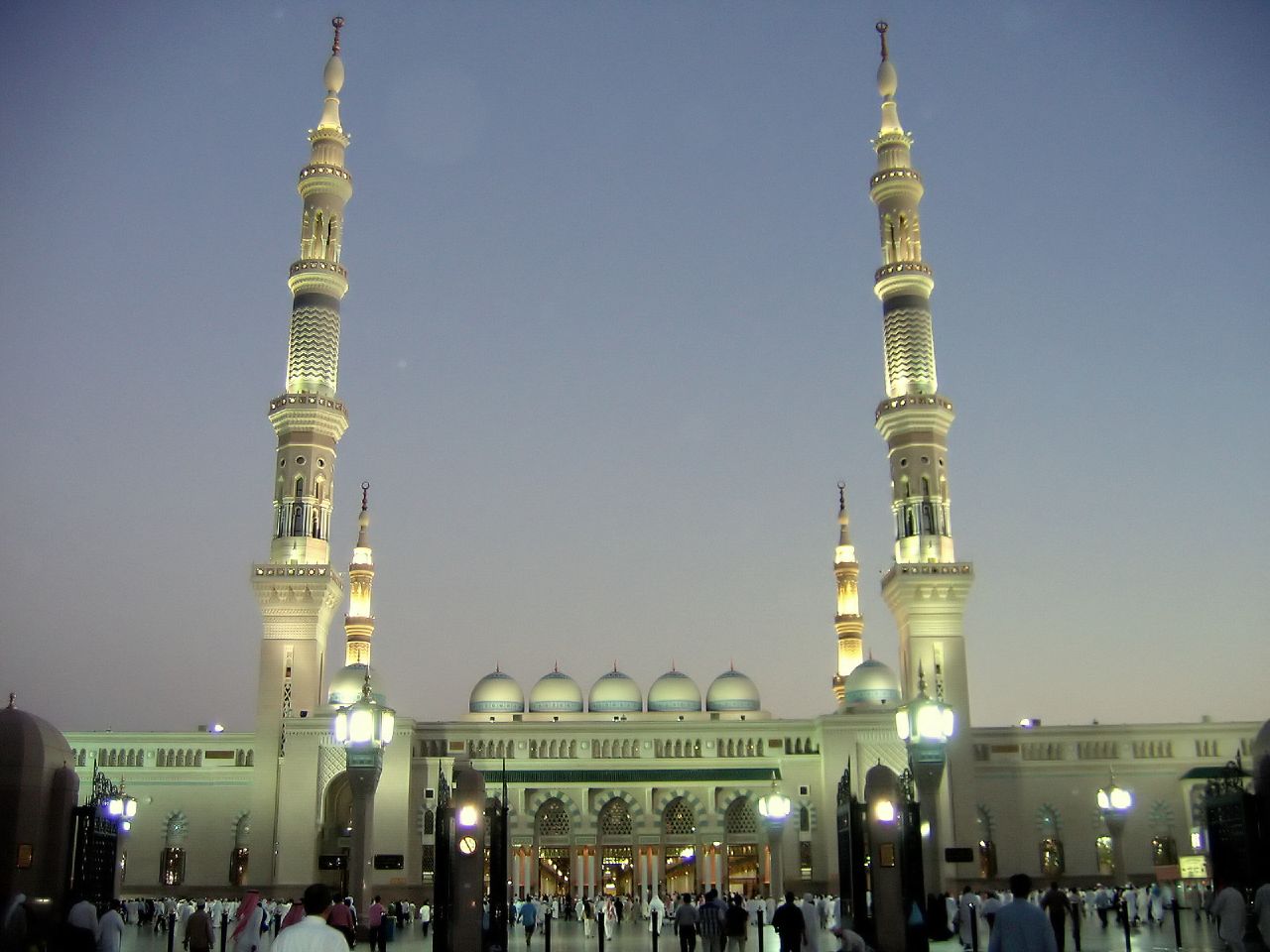
Al-Masjid an-Nabawi (Arabic: المسجد النبوي, pronounced [ælˈmæsdʒidæˈnːæbæwiː]) or the Mosque of the Prophet, located in Medina, is the second holiest site in Islam.
The Mosque was originally the house of Muhammad (pbuh); he settled there after his migration to Medina, and later built a mosque on the grounds. He himself shared in the heavy work of construction. The original mosque was an open-air building. The mosque also served as a community center, a court, and a religious school. There was a raised platform for the people who taught the Quran. The basic plan of the building has been adopted in the building of other mosques throughout the world.
Subsequent Islamic rulers greatly expanded and decorated the mosque. The most important feature of the site is the green dome over the center of the mosque, where the tomb of Muhammad is located. Constructed in 1817 CE and painted green in 1839 CE, it is known as the Dome of the Prophet. Early Muslim leaders Abu Bakr and Umar (R.A.) are buried beside Muhammad (pbuh).
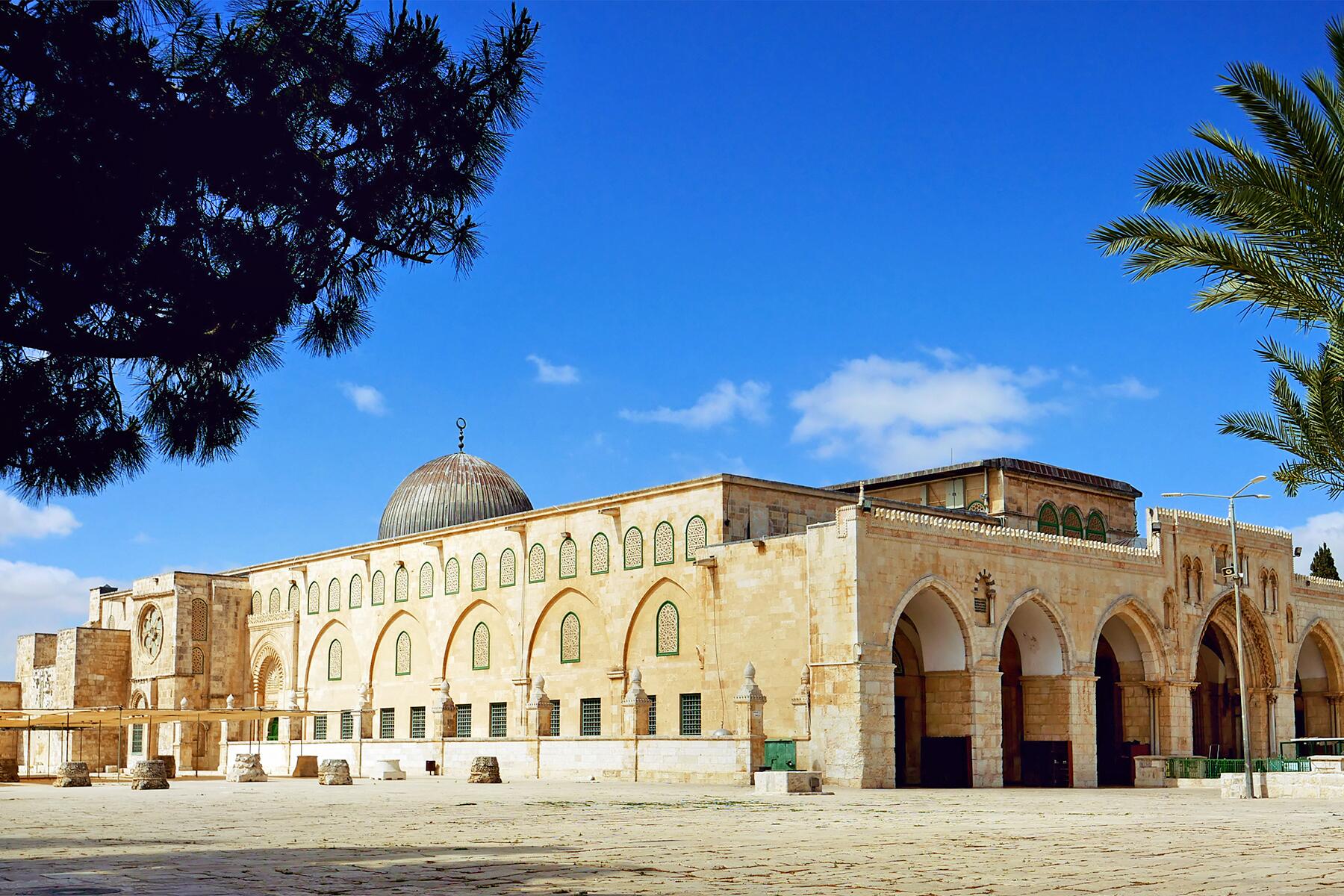
Masjid Al-Aqsa (“the Farthest Mosque”), also known as the “Al Aqsa compound”, is a holy site in Sunni and Shia Islam and is located in the Old City of Jerusalem, and is widely regarded by Jews as the Temple Mount, the site of the Holy Temple. It includes the Qibli mosque and the Dome of the Rock. It is the third holiest site in Islam. The term Al-Aqsa Mosque was coined in the Quran:
Glory to (Allah) Who did take His servant for a Journey by night from the Sacred Mosque to the Farthest Mosque, whose environs We did bless,- in order that We might show him some of Our Signs: for He is the One Who heareth and seeth (all things). — Quran, Sura 17 (Al-Isra) ayah 1
Al-Aqsa Mosque is sacred because the “first of the two qiblas” (Arabic: اولى القبلتين) was Jerusalem. In Islamic tradition, Al-Aqsa is said to be the “second mosque” (Arabic: ثاني المسجدين), as well as the “third of the holy sanctuaries” (Arabic: ثالث الحرمين), under Islamic Law.
The term used for mosque, masjid, literally means “place of prostration”, and includes monotheistic or more specifically Abrahamic places of worship but does not exclusively lend itself to physical structures but a location, as Muhammad stated “The earth has been made for me (and for my followers) a place for praying…”. When Caliph Umar conquered Jerusalem after Muhammad’s wafat, a prayer house was built on the site. The structure was expanded by the Umayyad caliph Abd al-Malik ibn Marwan and finished by his son al-Walid in 705 CE. The building was repeatedly destroyed by earthquakes and rebuilt, until the reconstruction in 1033 by the Fatimid caliph Ali az-Zahir, and that version of the structure is what can be seen in the present day. This same area was called at later Islamic periods as the Haram al-Sharif or the “Noble Sanctuary”.
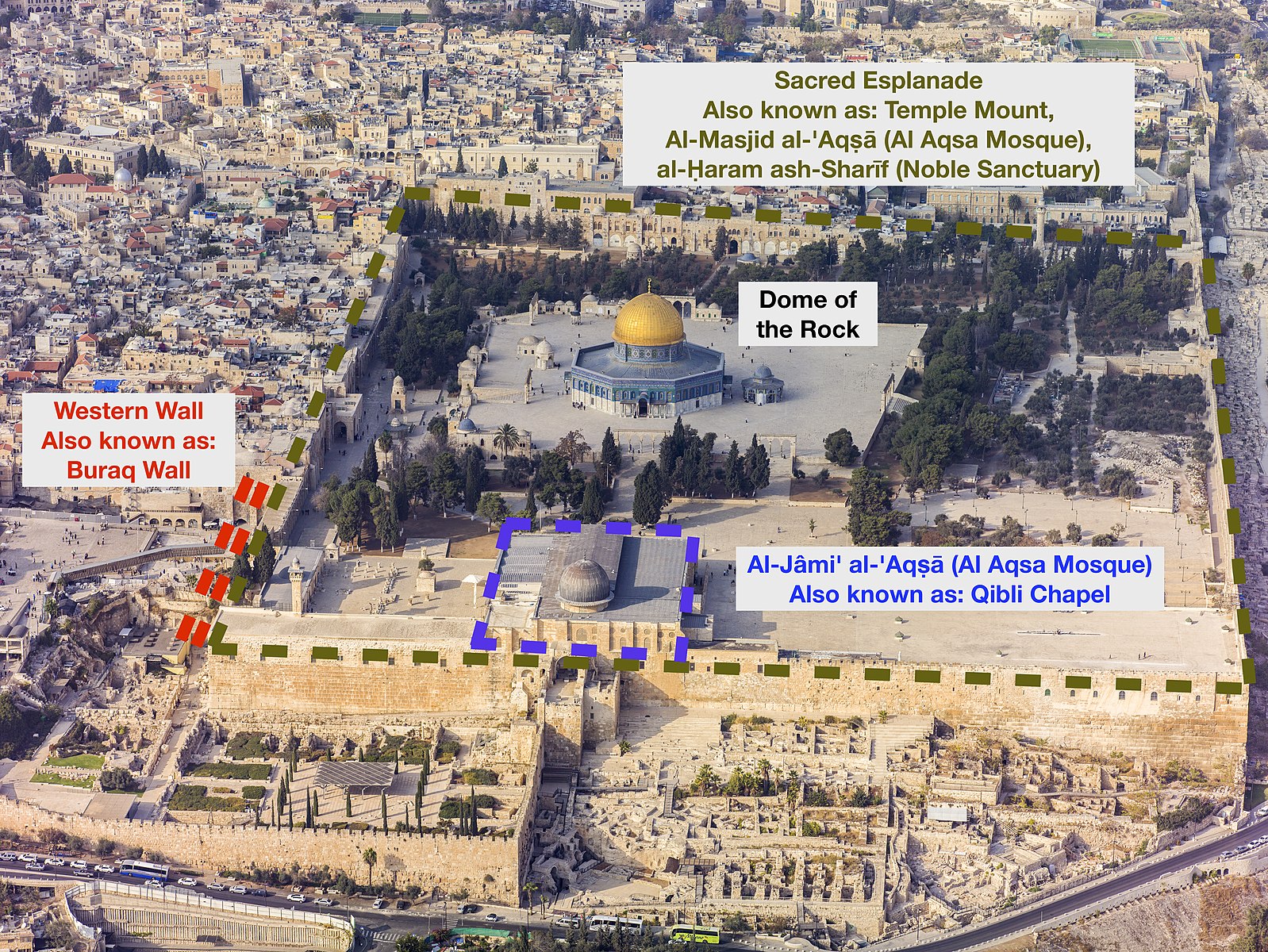
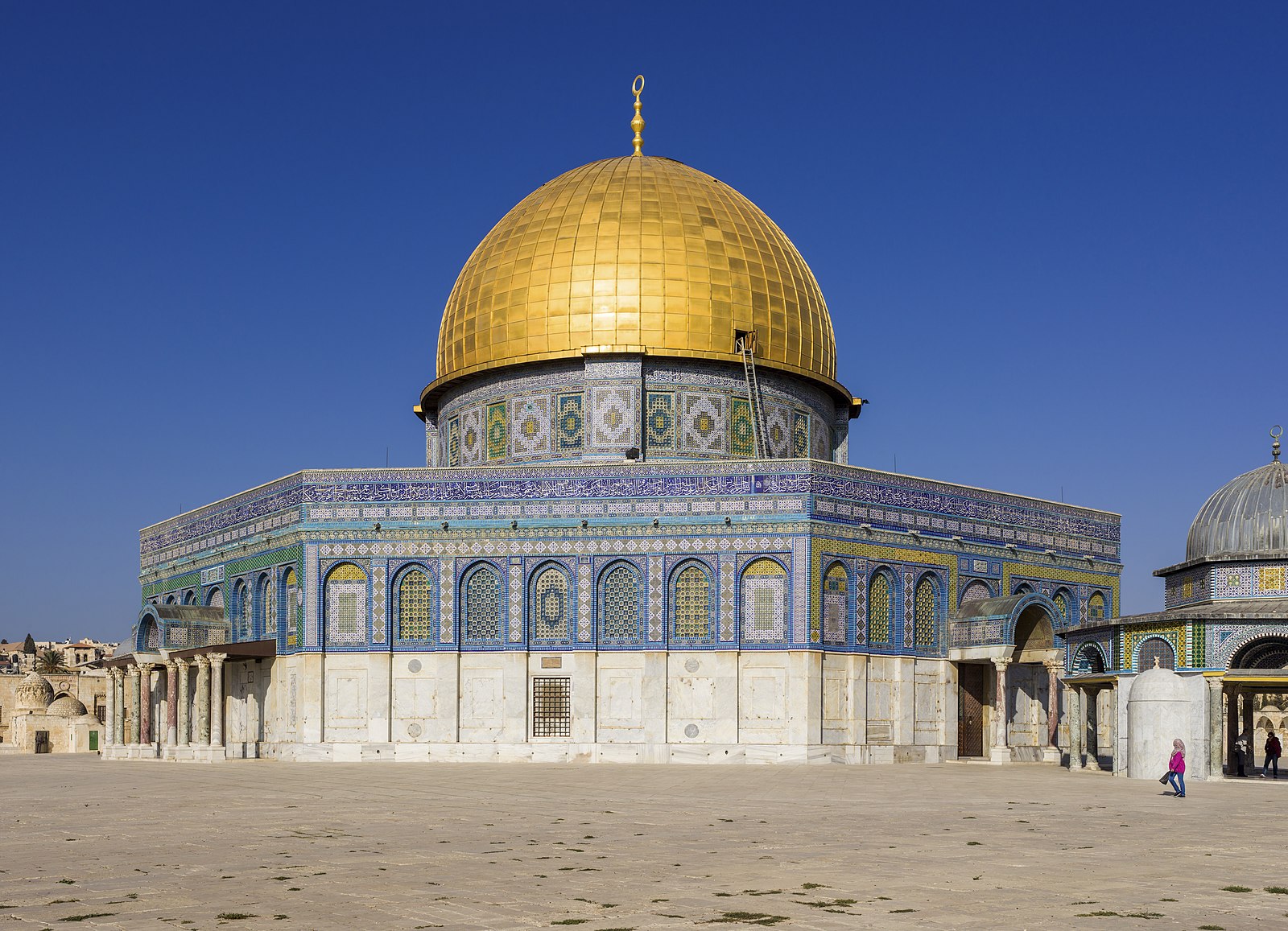
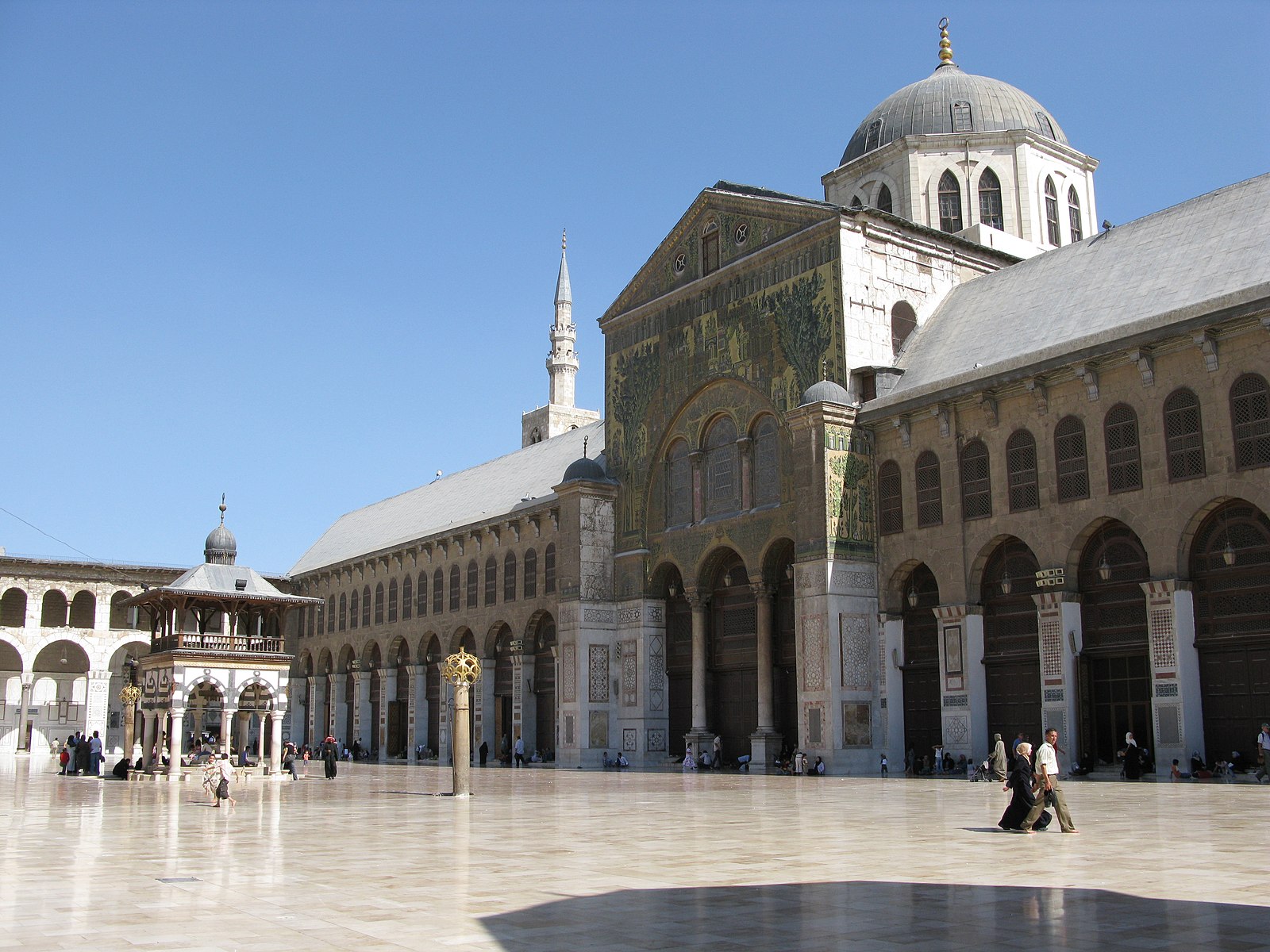
Umayyad Mosque in Damascus is considered by some Muslims to be the fourth holiest site in Islam. One of the four authorized copies of the Quran was kept here, and the head of Yahya ibn Zakariyya is believed to be in the shrine.
The Minaret of Isa in the Umayyad Mosque is dedicated to Isa (Jesus), and it is believed that he will return to the world at the minaret during the time of a Fajr prayer and it is believed that he will pray at the mosque with the Islamic leader of that time Mahdi. It is believed that prayers in the mosque are considered to be equal to those offered in Jerusalem
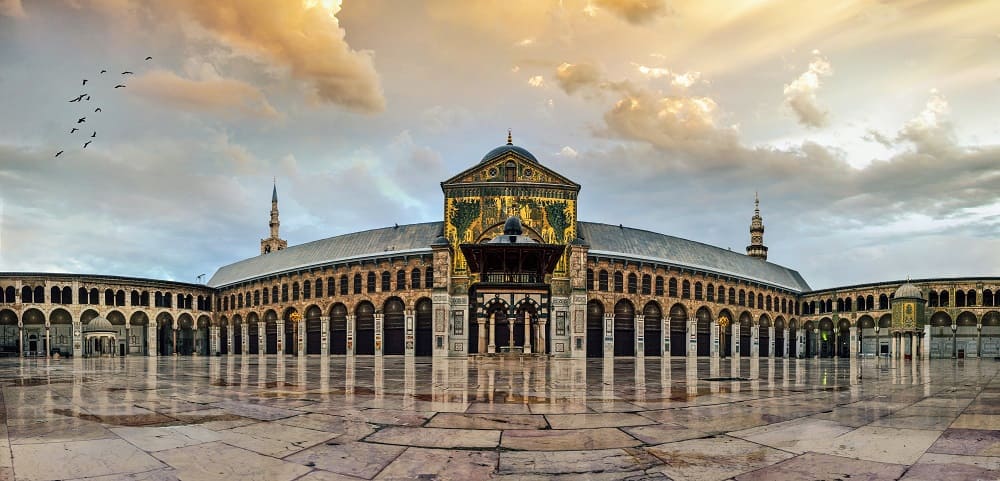
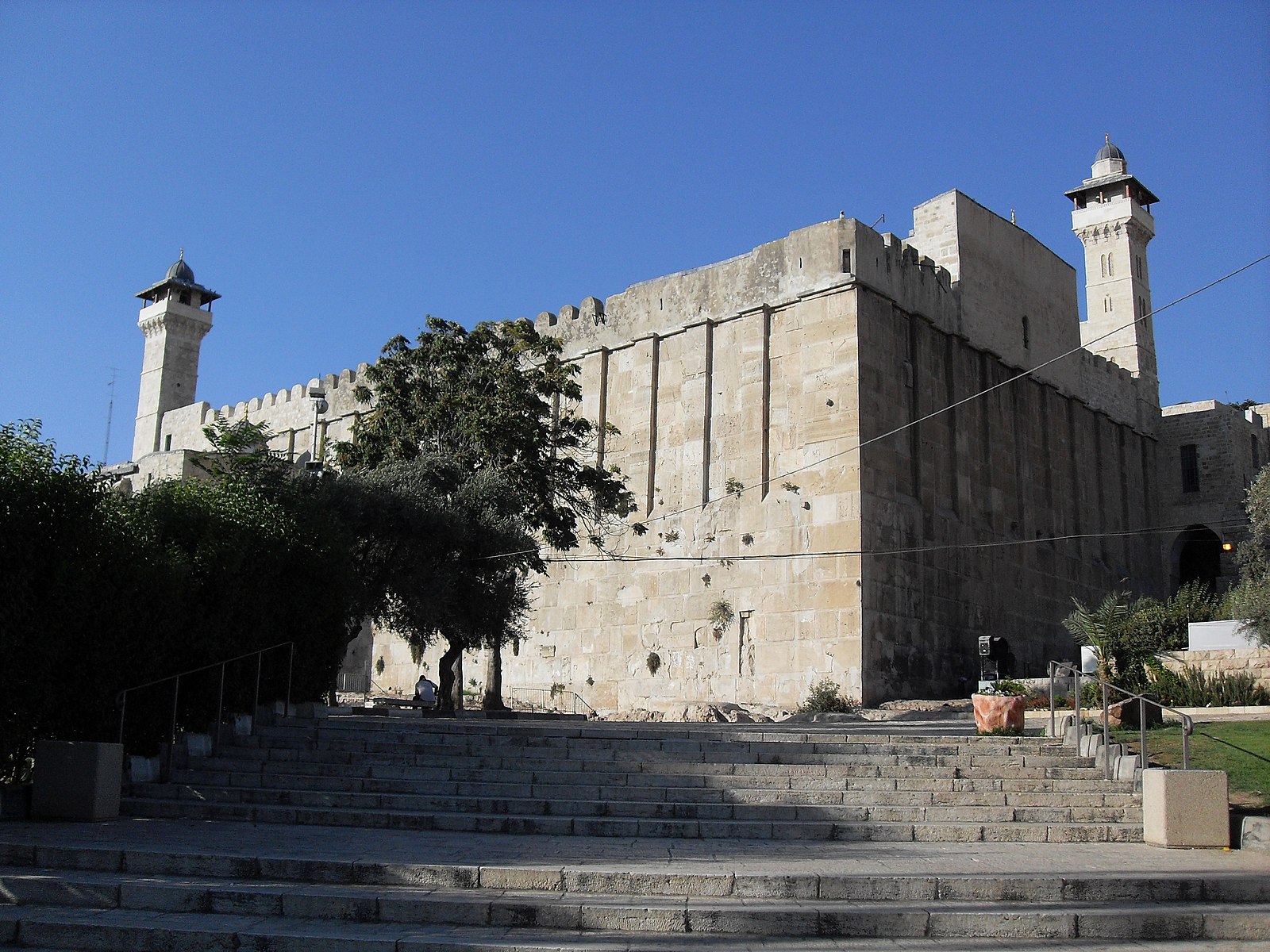
Ibrahimi Mosque in Hebron, West Bank, Palestine, allegedly contains the graves of the Prophet Abraham (pbuh) and some of his family, and is for that reason also considered by some Sunni Muslims the fourth holiest site in the world. It was said that Muhammad himself encouraged the activity, saying “He who cannot visit me, let him visit the Tomb of Abraham” and “He who visits the Tomb of Abraham, Allah abolishes his sins.
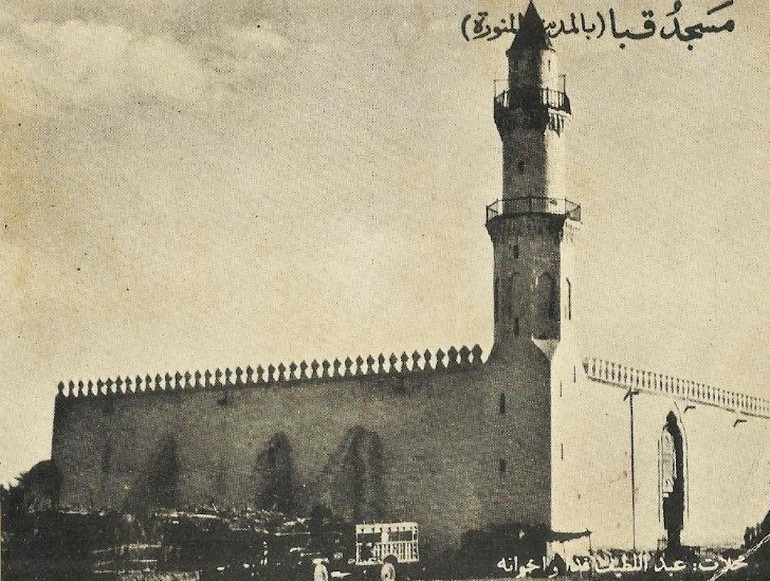
The Quba Mosque (Arabic: مَسْجِد قُبَاء, romanized: Masjid Qubāʾ) is a mosque located in Medina, in the Hejazi region of Saudi Arabia, built in the lifetime of the Islamic prophet Muhammad in the 7th century C.E. It is thought to be the first mosque in the world, built on the first day of Muhammad’s emigration to Medina. Its first stone is said to have been laid by the prophet, and the structure completed by his companions.
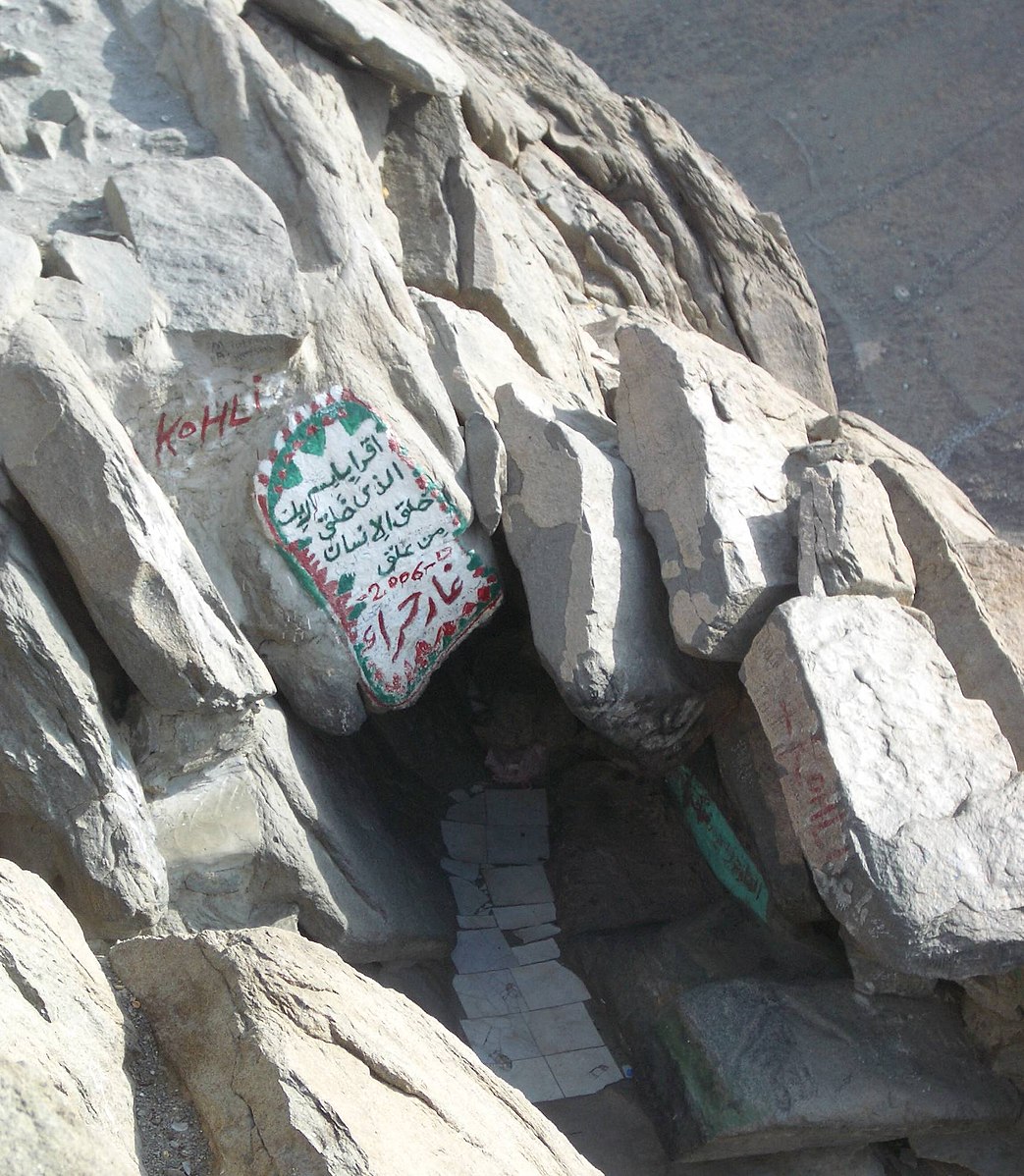
The Cave of Hira was of minor significance before Islam, its name comes from hira (jewels). Taking 1750 walking steps to reach, it is about 3.7 m (12 ft) in length and 1.60 m (5 ft 3 in) in width. It is at a height of 270 m (890 ft).It is the place here Prophet Muhammad (pbuh) is to have received the first revelation of the Quran on the Laylat al-Qadr (night of power) by the angel Jibreel (Gabriel).
While the cave plays an important role in As-Sīrah an-Nabawiyyah (prophetic biography), it is not considered as holy as other sites in Mecca, such as the Al-Haram Mosque.
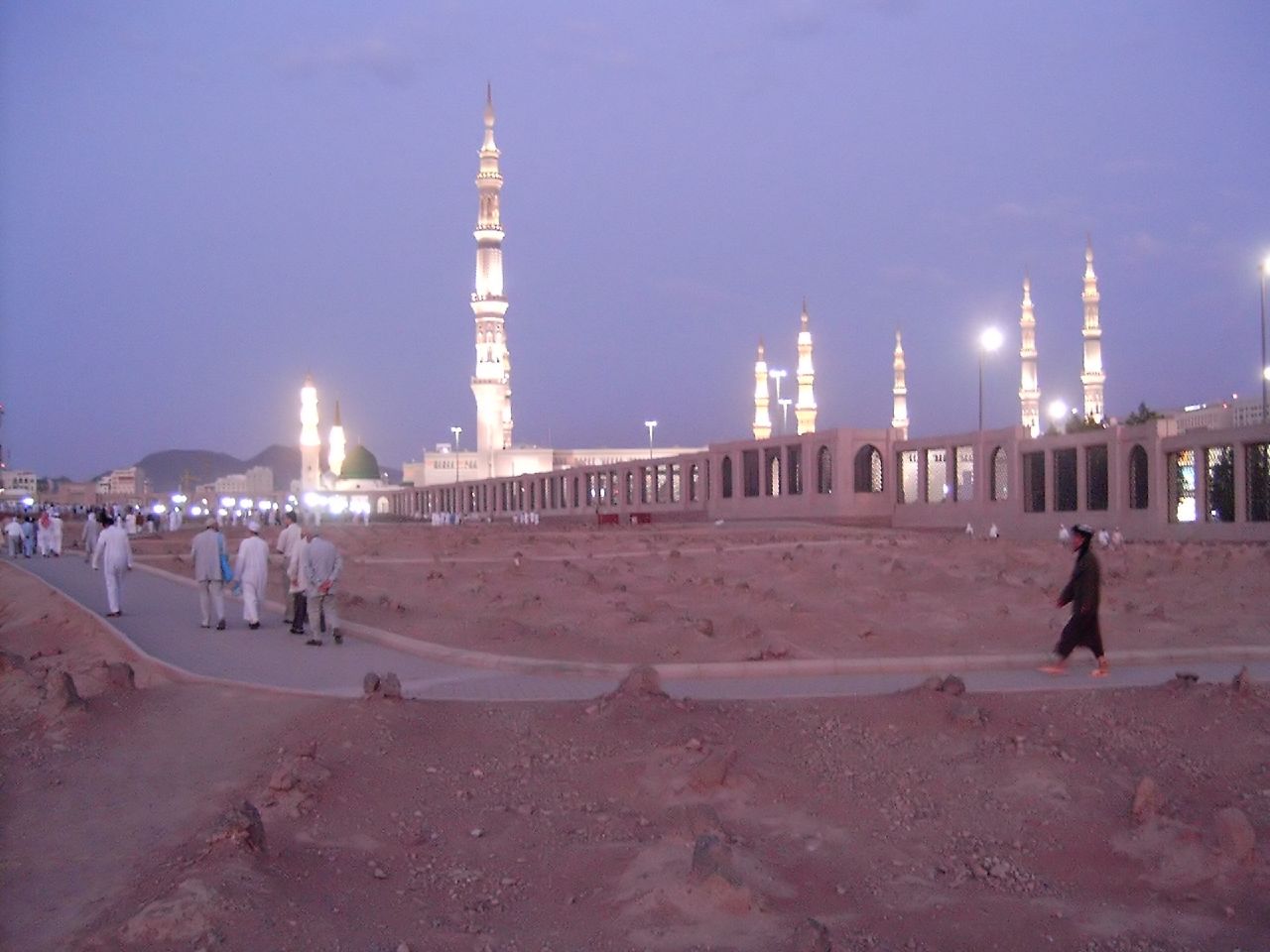
Jannat al-Baqīʿ (Arabic: ٱلْبَقِيْع, “The Baqi'”) is the oldest and the first Islamic cemetery of Medina in the Hejazi region of present-day Saudi Arabia. It is the oldest Islamic cemetery, where Caliph Uthman, Fatimah, Caliph Hasan ibn Ali and Aisha (R.A.)were buried.
It is located to the southeast of the Prophet’s Mosque, which contains the graves of some of the Islamic prophet Muhammad‘s (pbuh) family and friends. It is also known as Baqīʿ al-Gharqad (Arabic: بَقِيْع الْغَرْقَد, meaning “Baqiʿ of the Boxthorn“).
The grounds hold much significance for Muslims; its status as the resting place of many of Muhammad’s (pbuh) relatives and companions establishes it as one of the two holiest cemeteries in Islamic tradition. Many narrations relate Muhammad issuing a prayer every time he passed it.
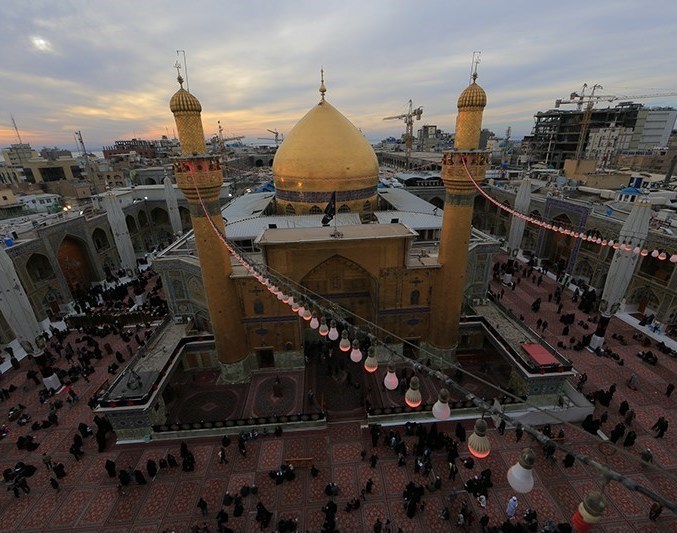
The Sanctuary of Imām ‘Alī (Arabic: حَرَم ٱلْإِمَام عَلِيّ, romanized: Ḥaram al-ʾImām ʿAlī), also known as the Mosque of ‘Alī (Arabic: مَسْجِد عَلِيّ, romanized: Masjid ʿAlī), located in Najaf, Iraq, is a mosque which many Muslims believe contains the tomb of ‘Alī ibn Abī Tālib, a cousin, son-in-law and companion of the Islamic prophet Muhammad. The Shī’as consider ‘Alī as their first Imām, and the Sunnis regard him as the fourth Sunni Rashid Caliph. According to Shī’ite belief, buried next to ‘Alī within this mosque are the remains of Adam and Nuh (Noah). Each year, millions of pilgrims visit the Shrine and pay tribute to Imām ‘Alī.
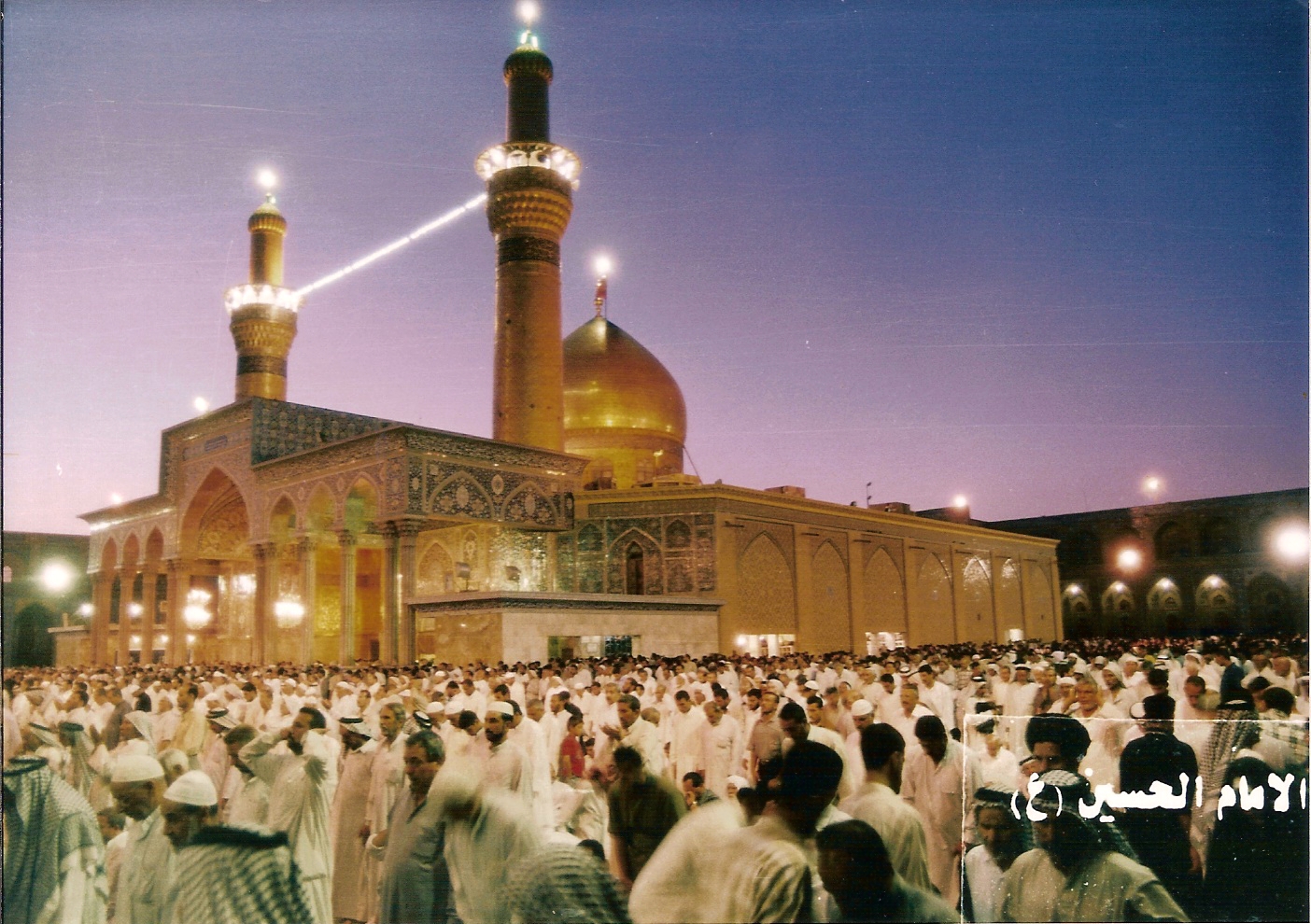
The Imam Husayn Shrine (Arabic: مَقَام ٱلْإِمَام ٱلْحُسَيْن ٱبْن عَلِيّ, romanized: Maqām al-ʾImām al-Ḥusayn ʾibn ʿAlī) is the mosque and burial site of Husayn ibn Ali, the third Imam of Shia Islam, in the city of Karbala, Iraq. It stands on the site of the Mausoleum of Husayn, who was a grandson of Muhammad (pbuh), near the place where he embraced martyrdom during the Battle of Karbala in 680 CE. The tomb of Husayn is one of the holiest sites in Shia Islam, outside of Mecca and Medina, and many make pilgrimages to the site. Every year, millions of pilgrims visit the city to observe Ashura, which marks the commemoration of Husayn’s death for all Muslims. It is the mosque where Imam Husayn ibn Ali, and his relatives such as Abbas ibn Ali, Ali al-Akbar ibn Husayn, Ali al-Asghar ibn Husayn, Habib ibn Muzahir, and other martyrs of Karbalā were buried.
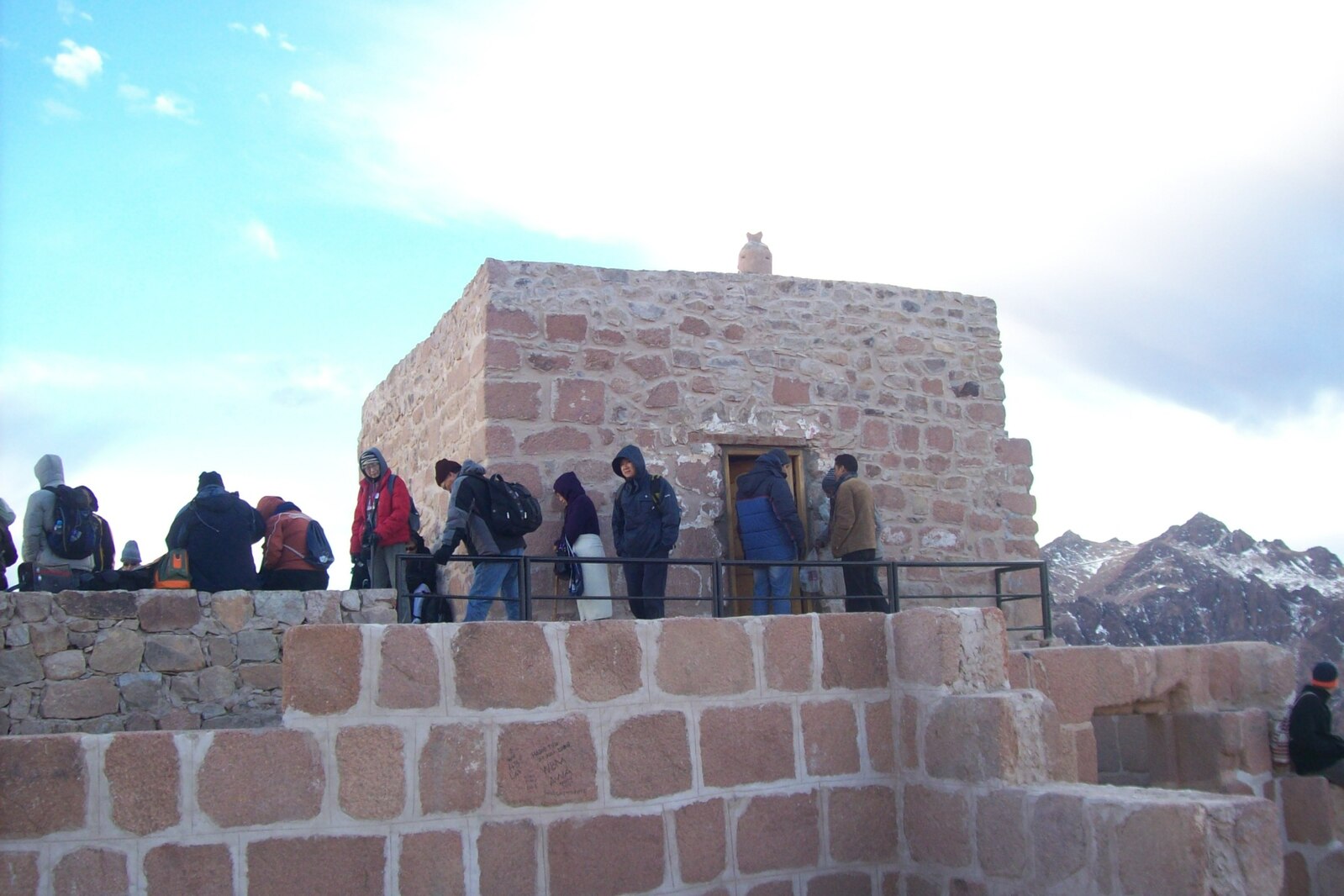
The Sinai Peninsula is associated with the prophets Harun (Aaron) and Musa (Moses) (pbut). In particular, numerous references to Mount Sinai exist in the Quran, where it is called Ṭūr Saināʾ, Ṭūr Sīnīn, and aṭ-Ṭūr and al-Jabal (both meaning “the Mount”). As for the adjacent Wād Ṭuwā (Valley of Tuwa), it is considered as being muqaddas (sacred), and a part of it is called Al-Buqʿah Al-Mubārakah (“The Blessed Place”).
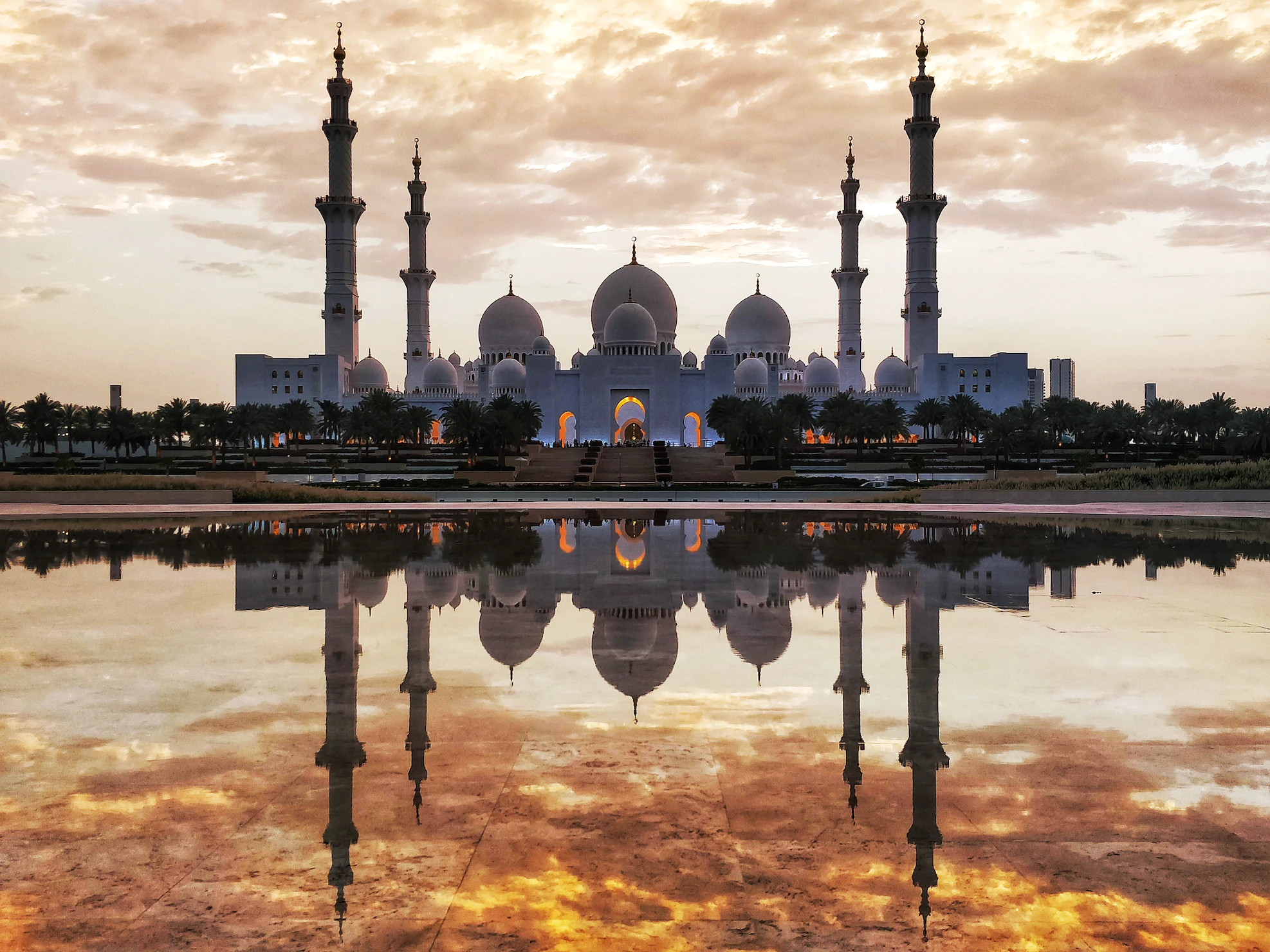
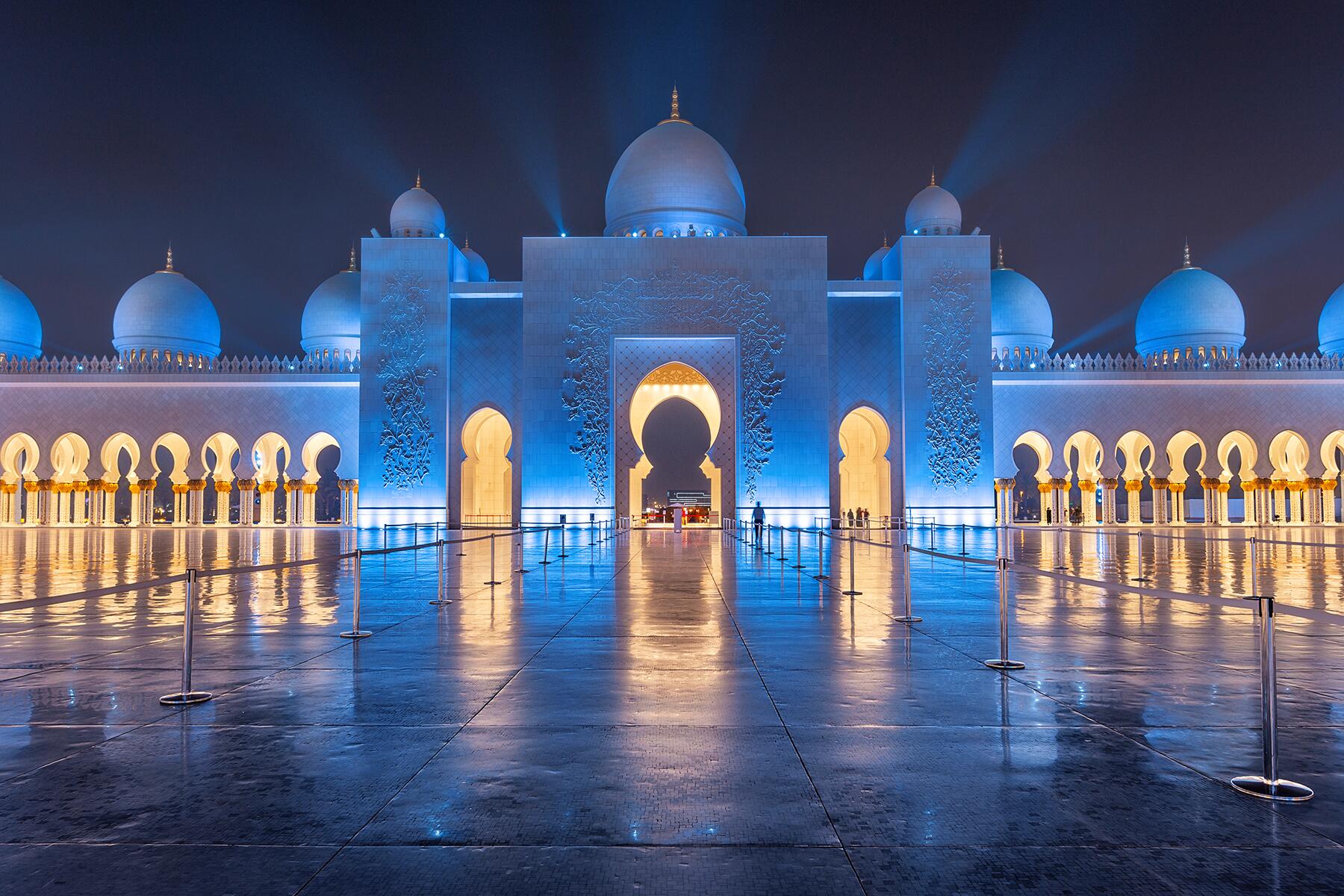
The Sheikh Zayed Grand Mosque is located in Abu Dhabi, the capital city of the United Arab Emirates. Constructed between 1996 and 2007 and covering an area of more than 12 hectares, its design incorporates architectural features from a range of different Islamic cultures, including Turkish, Moroccan, Pakistani, and Egyptian. With room inside to accommodate over 40,000 worshippers, it’s the outside that really captures the eye, especially the vast 17,000-square-meter courtyard that’s made entirely of mosaic marble.
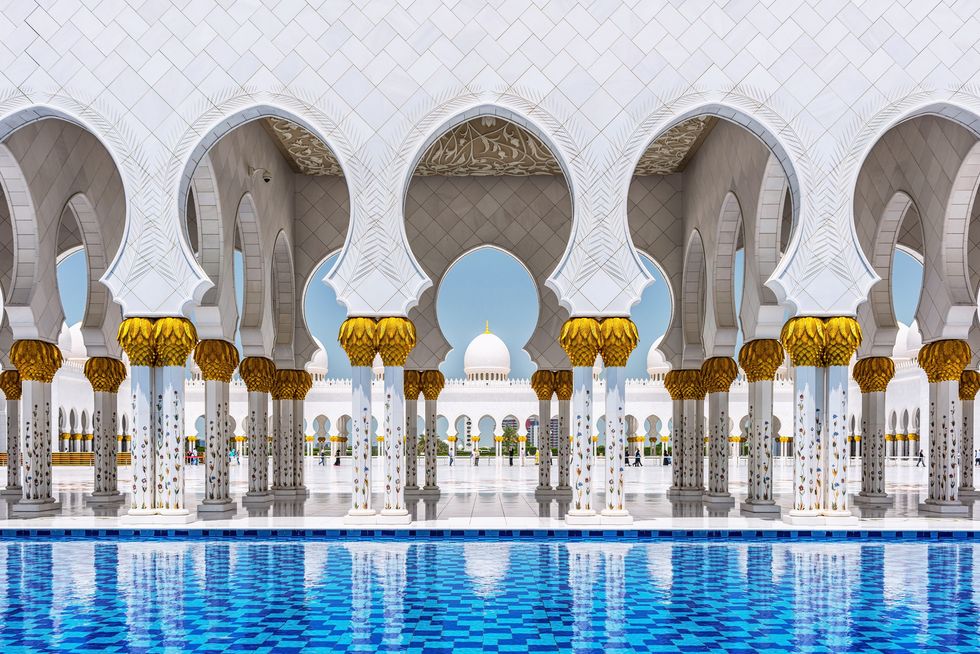
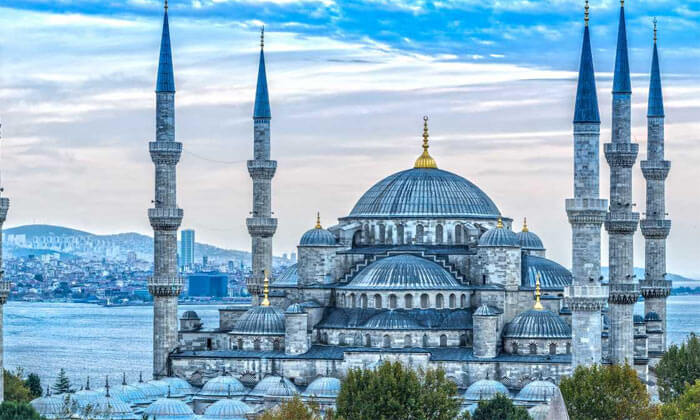
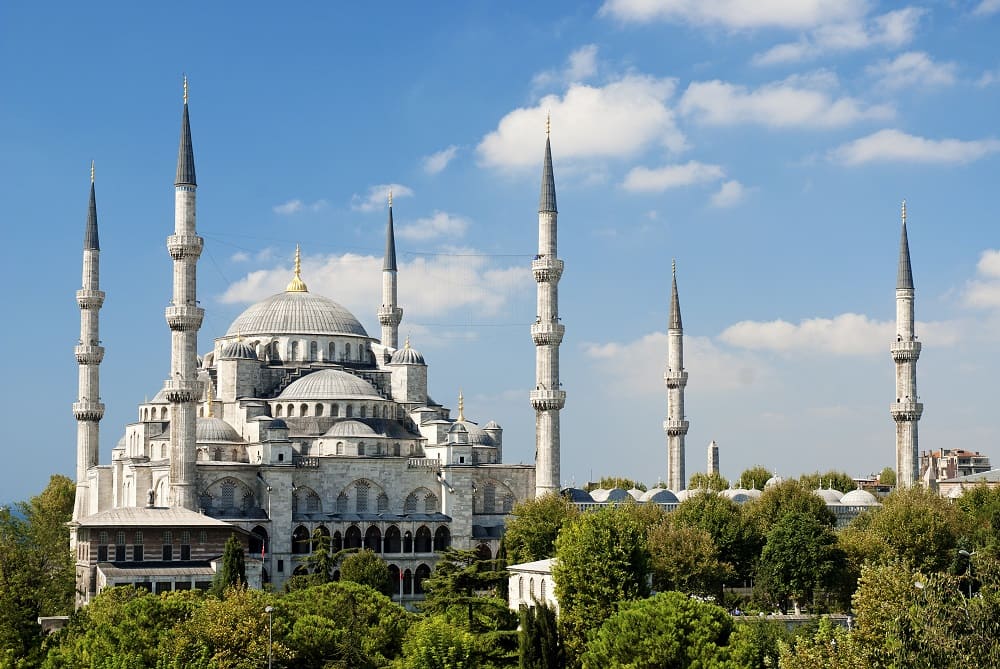
Considered one of the last classical Ottoman structures, the Sultan Ahmet Mosque earned its nickname as the Blue Mosque for its blue Iznik tiles that decorate the interior walls. Sultan Ahmet I commissioned the construction of the mosque in 1609 as a way to mark his legacy as a ruler. However, the young leader was only able to enjoy the masterpiece of Islamic architecture for a short time before his untimely death in 1617, the same year the mosque was completed.
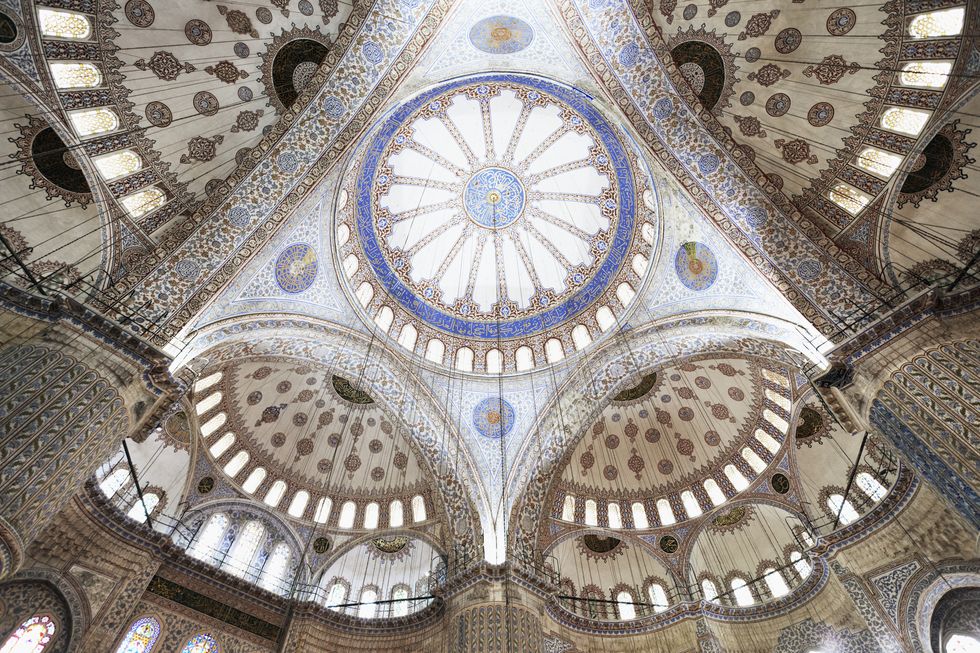
Considered one of the last classical Ottoman structures, the Sultan Ahmet Mosque earned its nickname as the Blue Mosque for its blue Iznik tiles that decorate the interior walls. Sultan Ahmet I commissioned the construction of the mosque in 1609 as a way to mark his legacy as a ruler. However, the young leader was only able to enjoy the masterpiece of Islamic architecture for a short time before his untimely death in 1617, the same year the mosque was completed.
Constructed between 1609 and 1616 like a series domes and half domes, Blue Mosque, is one of the beautiful mosque in the world. The mosque is significant historically and architecturally as it boasts six needles like minarets and abundance of beauty. This beautiful Masjid brings the perfect mix of two centuries with hand- painted blue tiles, nicely carved and tablets inscribed with the verses from the Quran. It consists of five major domes, six huge minarets and eight secondary domes as a whole. The mosque is a true representation of traditional Islamic architecture and is considered to be the last great mosque of the classical period. Its huge variety of coloured domes and archways makes it look all the more the charming.
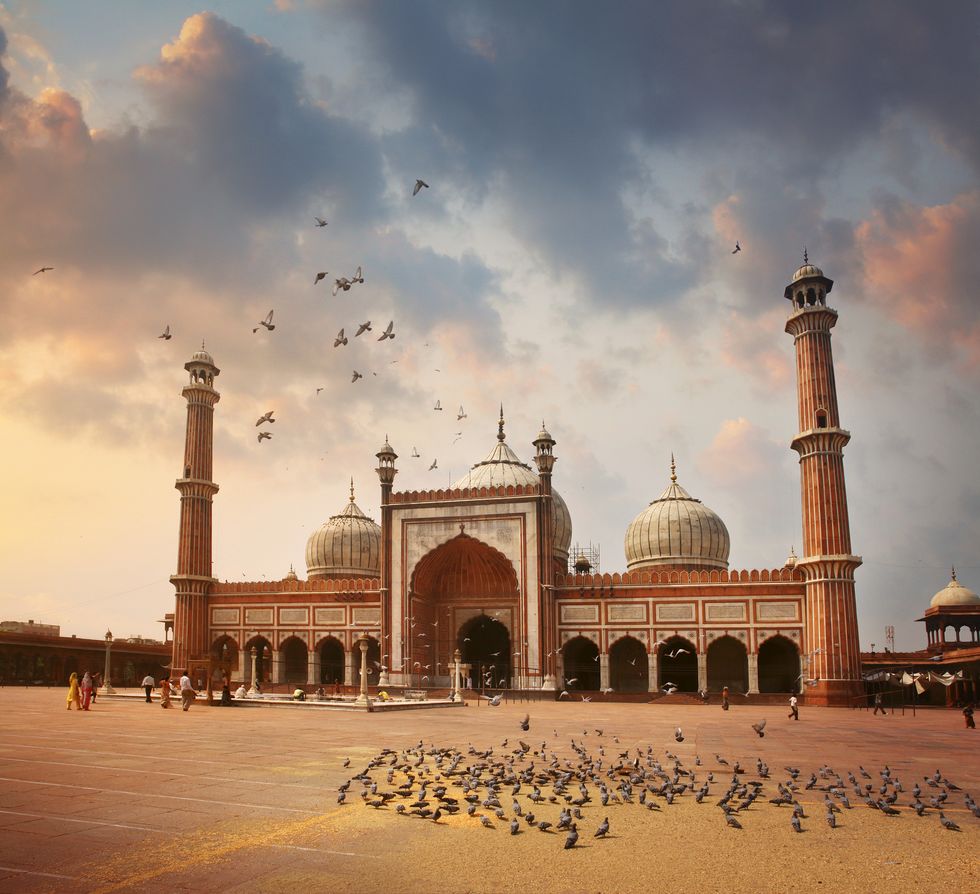
Jama Masjid in Delhi, India – Built between 1650 and 1656 by Emperor Shah Jahān, the marble and red sandstone mosque celebrates the opulence of Moghul architecture and design. The magnificent structures provide a quiet sanctuary away from the bustle of Old Delhi. The mosque’s staggering prayer hall can accommodate up to 25,000 people and the building features four watchtowers and two minarets. Archways with calligraphic inscriptions in Persian signify the entrance of the prayer hall while acting as the mosque’s hallmark.
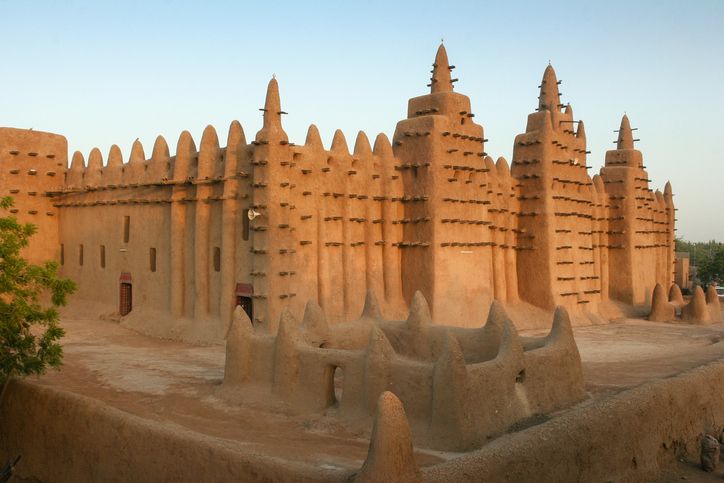
The Great Mosque of Djenné in Djenne, Mali – Mali’s Great Mosque of Djenné is regarded as one of the greatest achievements of Sudano-Sahelian architecture. Made of mud and adobe plaster, the original structure can roughly be traced back to the 13th century, though the mosque was reconstructed in 1907. One of the Great Mosque’s most distinctive features is the ostrich eggs placed at the very top of the pillars—they stand as a symbol of fertility and purity in the Malian region.
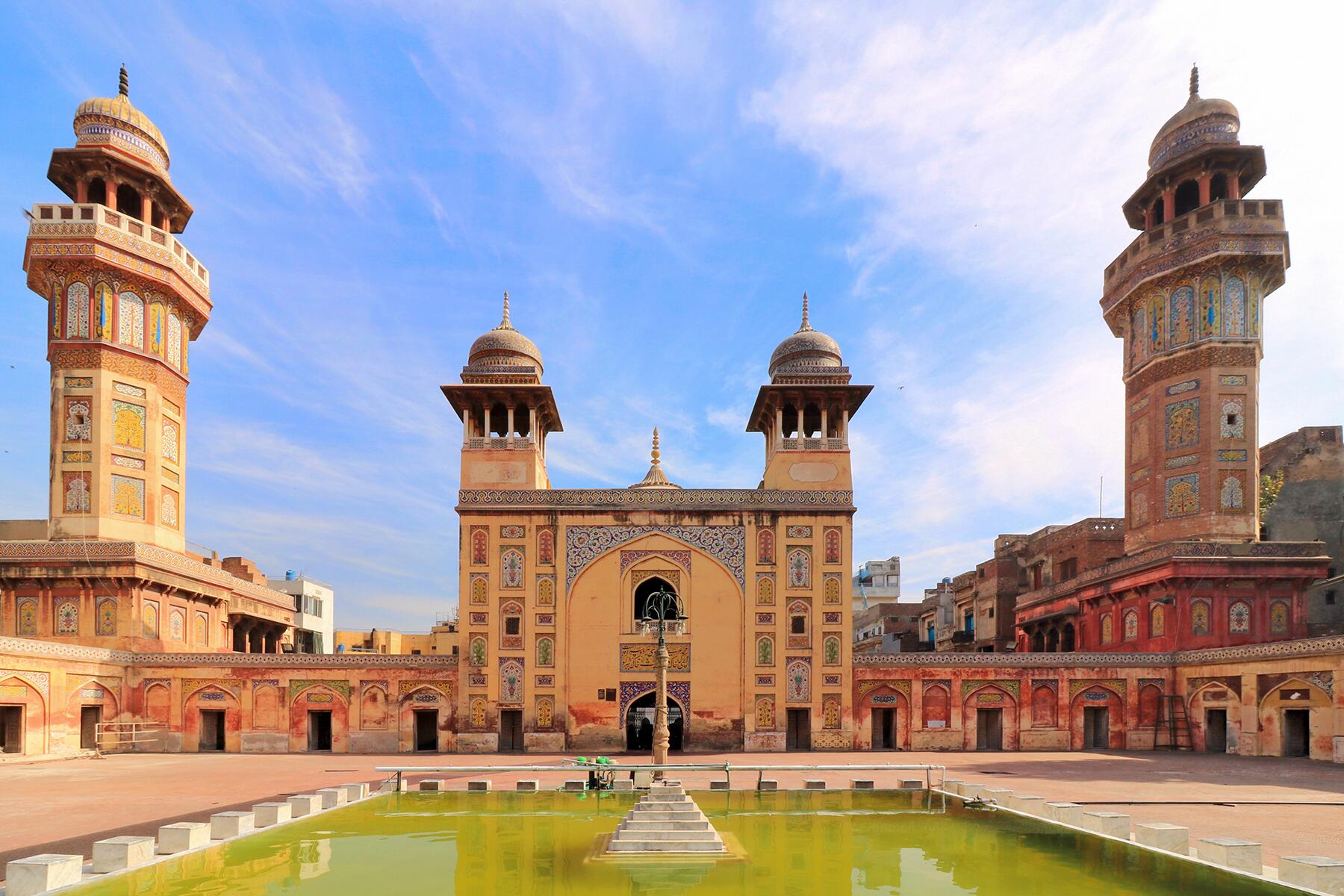
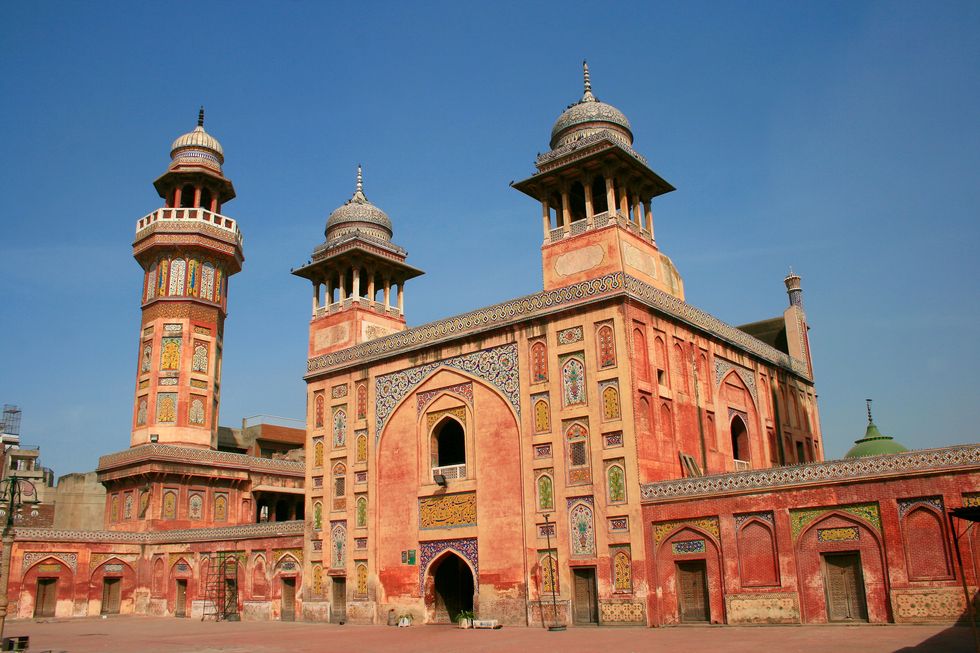
Masjid Wazir Khan in Lahore, Pakistan – Another masterpiece commissioned by Shah Jahān, the Wazir Khan Mosque makes a regal statement at the center of the inner walled city of Lahore. Intricate frescoes and detailed tilework cover almost every inch of the mosque’s walls from the four striking minarets found in the courtyard to the entrance to the prayer chamber. The Calligrapher’s Bazaar features famous passages from Islamic works outlined with florals and geometric patterns which were all painted by renowned khattats.
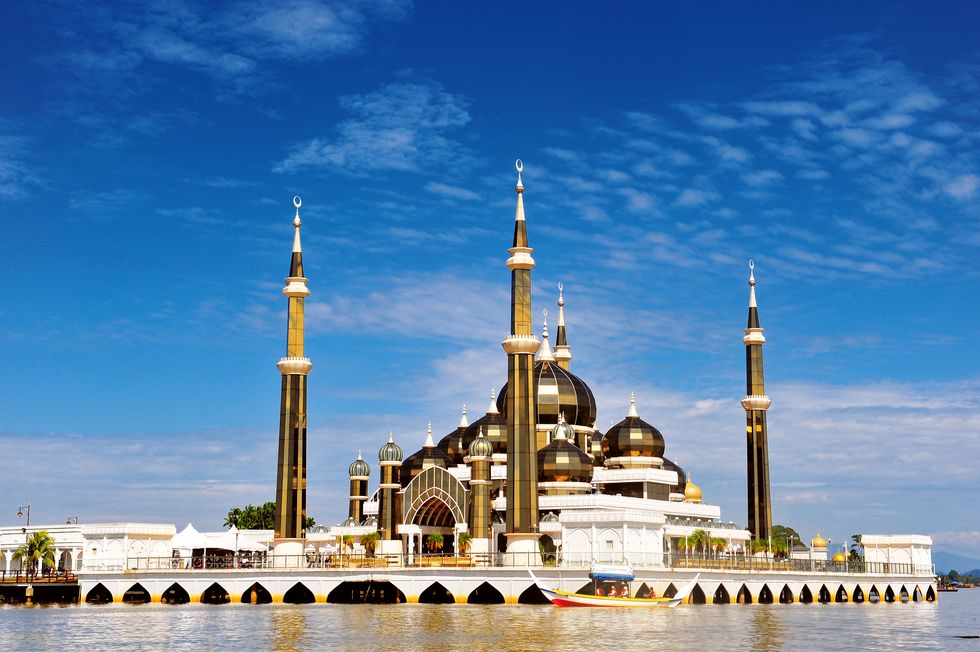
Crystal Mosque in Kuala Terengganu, Malaysia – Unlike most traditional mosques in the world, Malaysia’s Crystal Mosque exhibits a more modern and sleek look with its completely steel and glass structure. The glass domes of the mosque appear as though they are made of pure gold when the prayer halls and meeting rooms are illuminated from the inside. The Crystal Mosque also features a few Chinese-inspired details in its architecture and design.
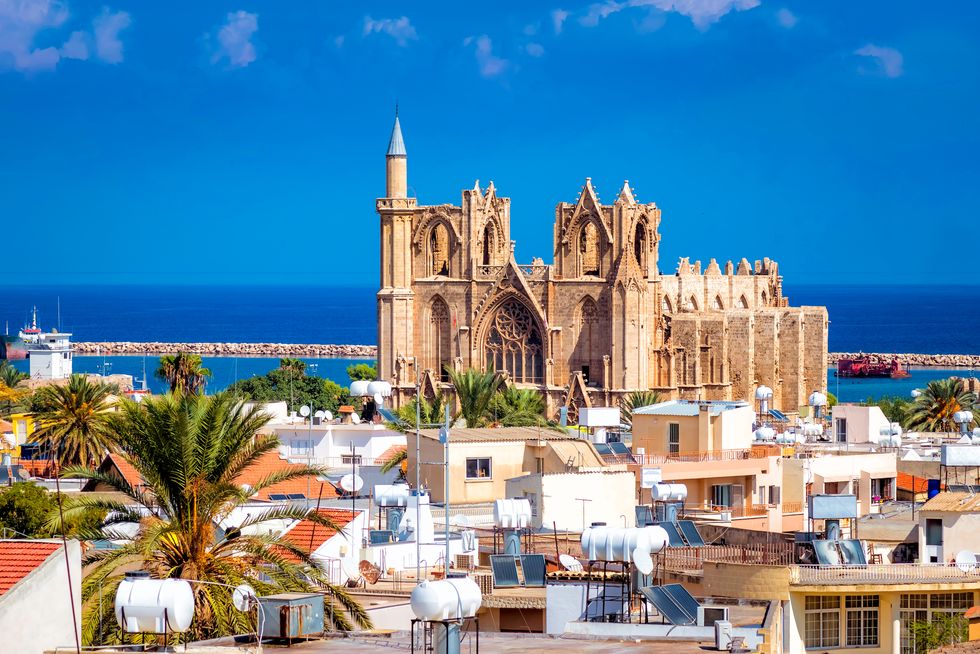
Lala Mustafa Pasha Mosque in Famagusta, Cyprus – Originally named the Latin Cathedral of Saint Nicholas, the Lala Mustafa Pasha Mosque features some of the more striking Frankish architecture in the Middle East. The structure is thought to have been designed by Frenchman Jean Langlois in the late 13th and 14th centuries. Over the centuries, it served as a holy site in the heart of Famagusta for a number of regions and denominations until it ultimately became a mosque in 1571.
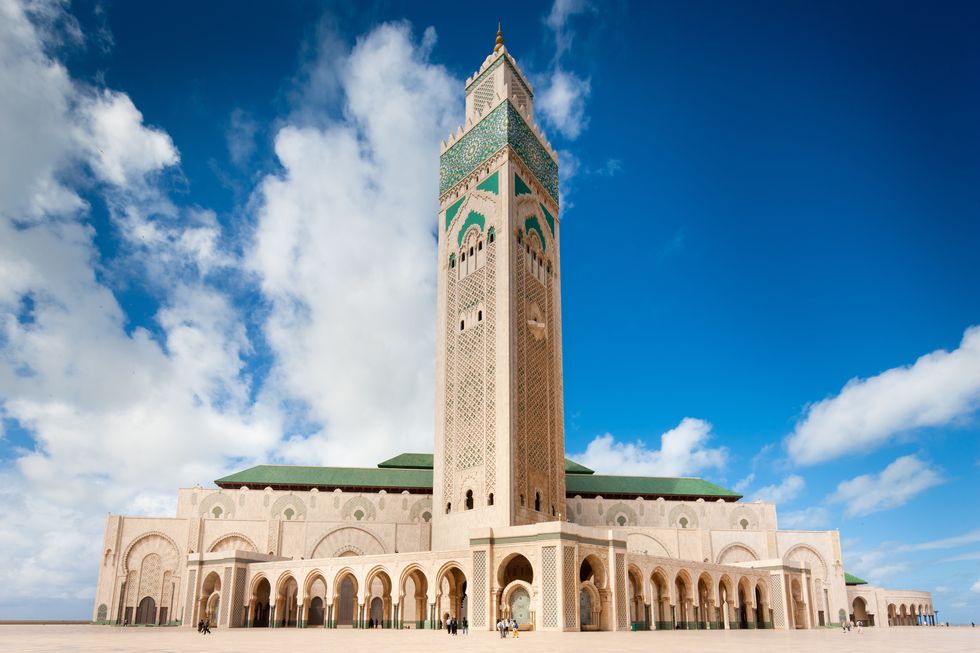
Hassan II Mosque in Casablanca, Morocco – Hand-carved stone, intricate mosaic tilework, and gilded ceilings showcase the excellence of Moroccan craftsmanship at the Hassan II Mosque. Overlooking the Atlantic Ocean, the 700-feet-tall minaret—the second largest in the world—marks the entrance from worshippers and visitors to the Casablanca landmark which includes a madrassa, hammams, a comprehensive museum, and an exquisite library.
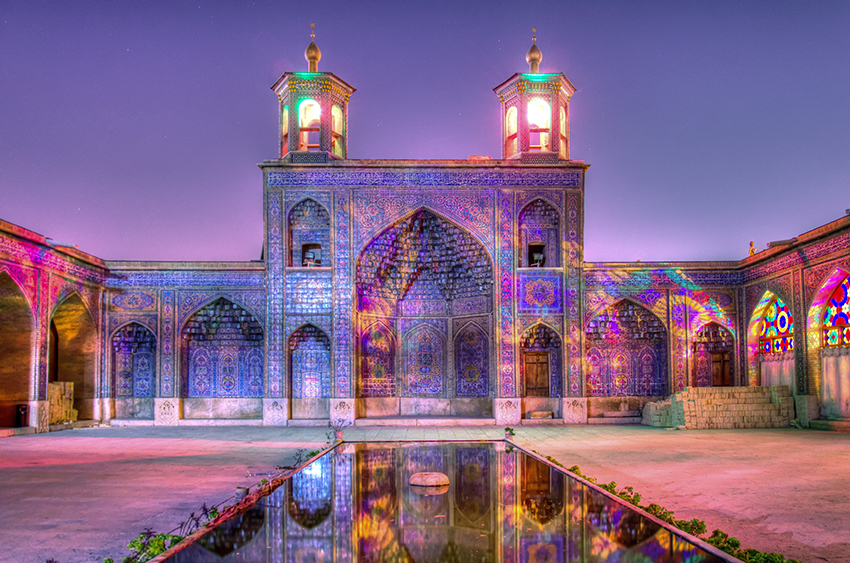
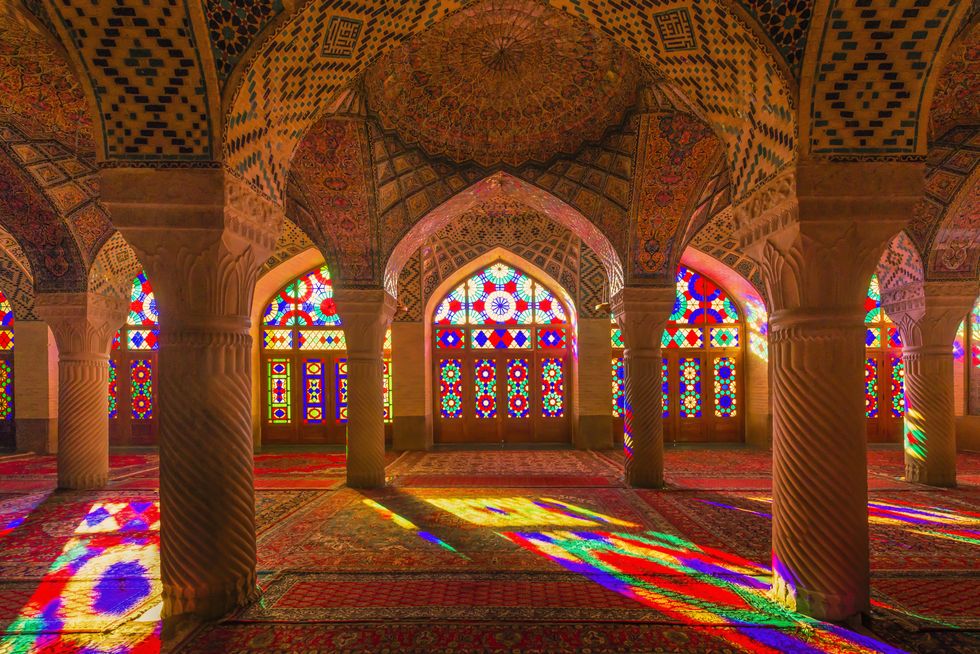
Nasir al-Mulk Mosque in Shiraz, Iran – Nestled in one of Iran’s oldest cities, the Nasir al-Mulk mosque boasts a renowned reputation for its vibrant tones and unlikely architectural features. The place of worship earned the nickname “Pink Mosque” for the intricate pink-colored tiles adorning the ceiling and arabesque arches. In the early morning hours, sunlight rushes through its distinctive stained-glass windows and decorates the Persian rug-covered floor with riotous color.
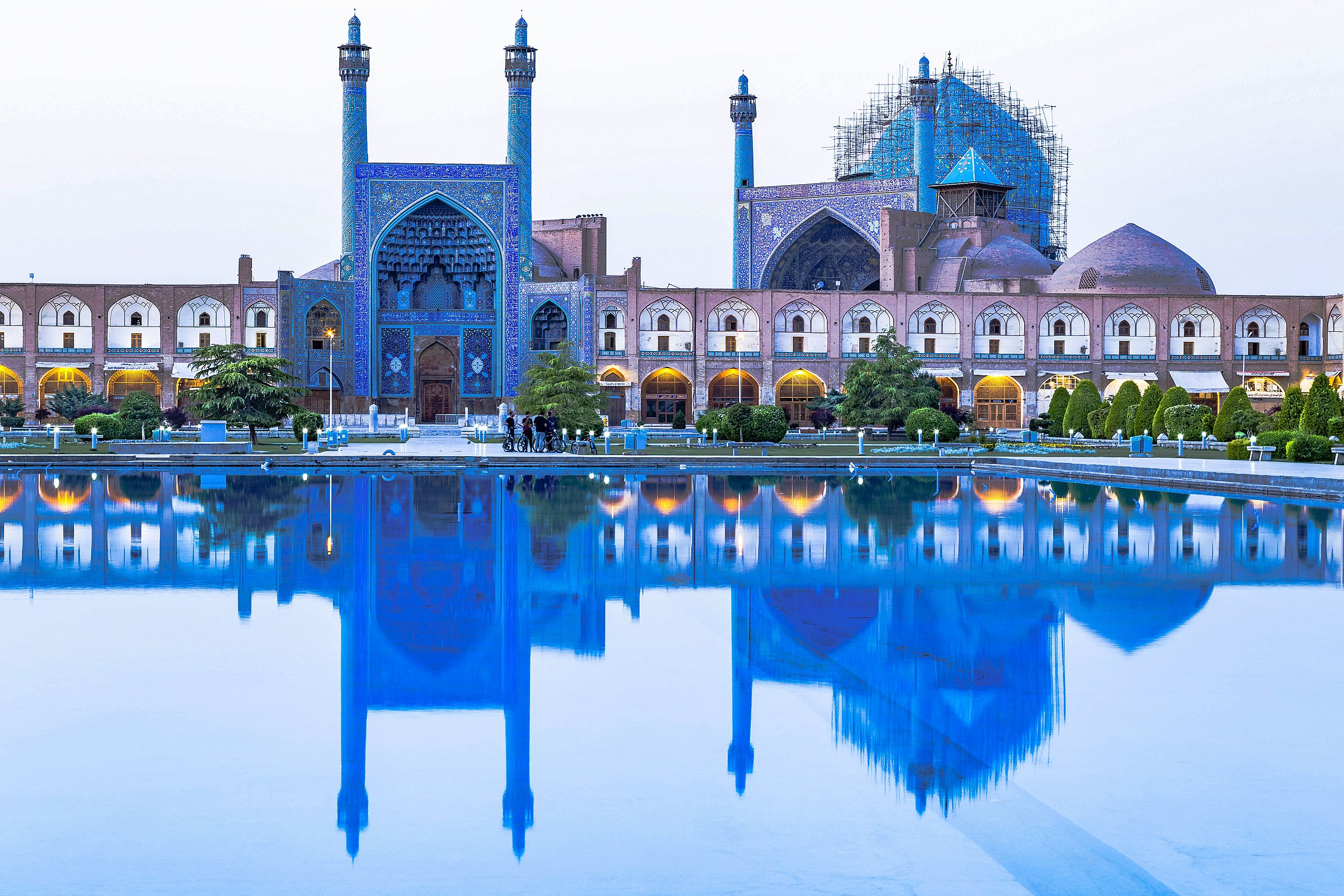
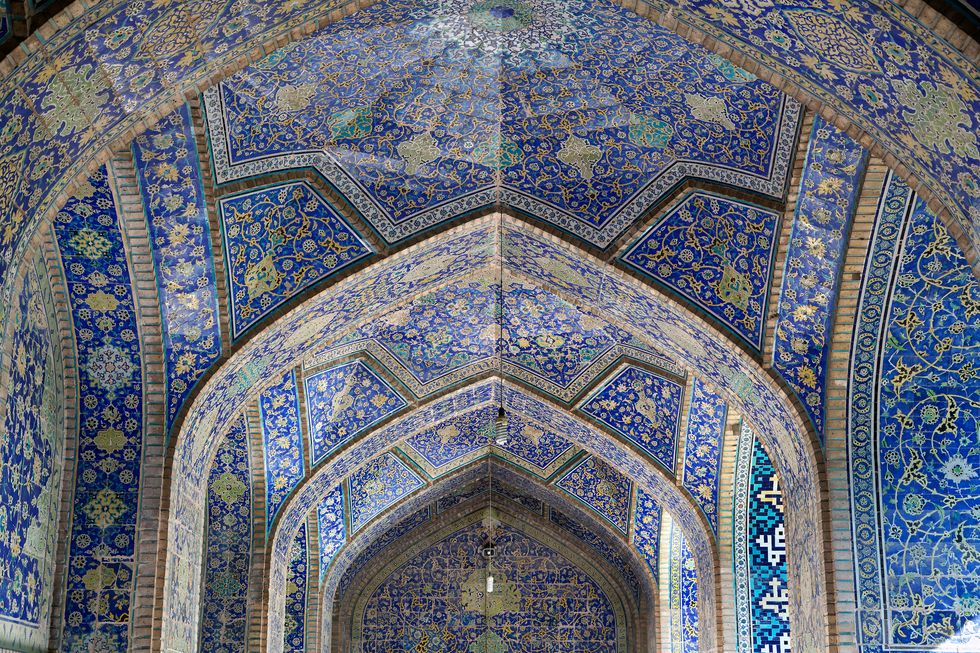
Shah Mosque in Isfahan, Iran – The acclaimed Shah Mosque stands as a landmark of decorative Persian architecture and art at the center of Isfahan’s Naqsh-e Jahan Square. Constructed in the early 17th century, the mosque features a haft rangi, or seven-color style of tile mosaic, where pictures are painted on rectangle tiles in shades of black, white, ultramarine, turquoise, red, yellow, and fawn.
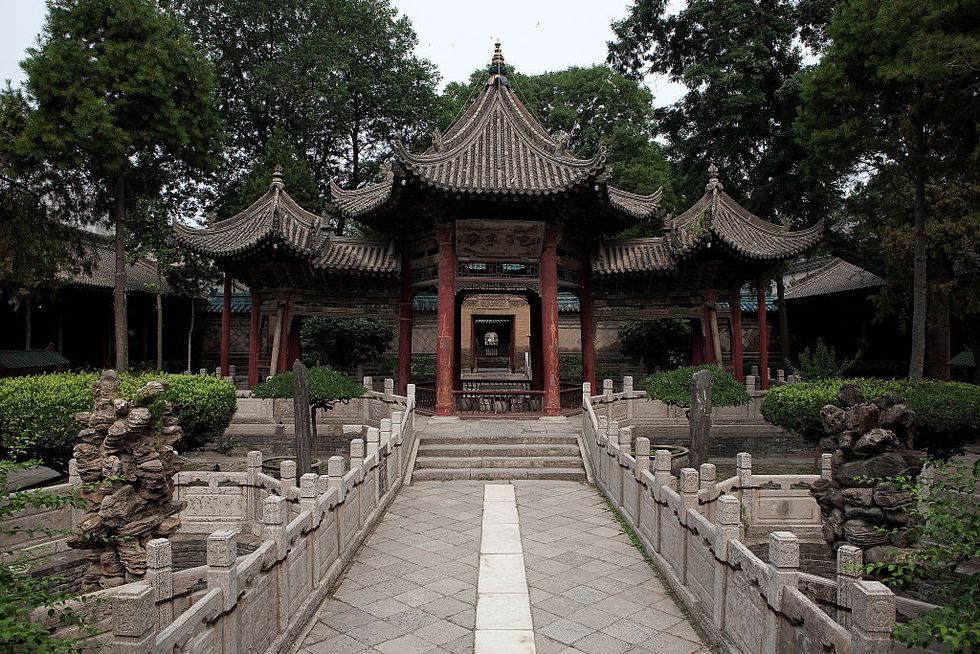
Great Mosque of Xi’an in Xi’an, China – A marriage of traditional Chinese architecture and Islamic practicality, the Great Mosque of Xi’an houses more than 20 building across its five courtyards, making it the largest mosque in China. Many of the sacred site’s architectural features pay homage to Persian roots while keeping in the style of the infrastructure during the Ming and Qing dynasty. For example, the pagoda within the third courtyard, called “Examining the Heart Tower,” serves as the mosque’s minaret.
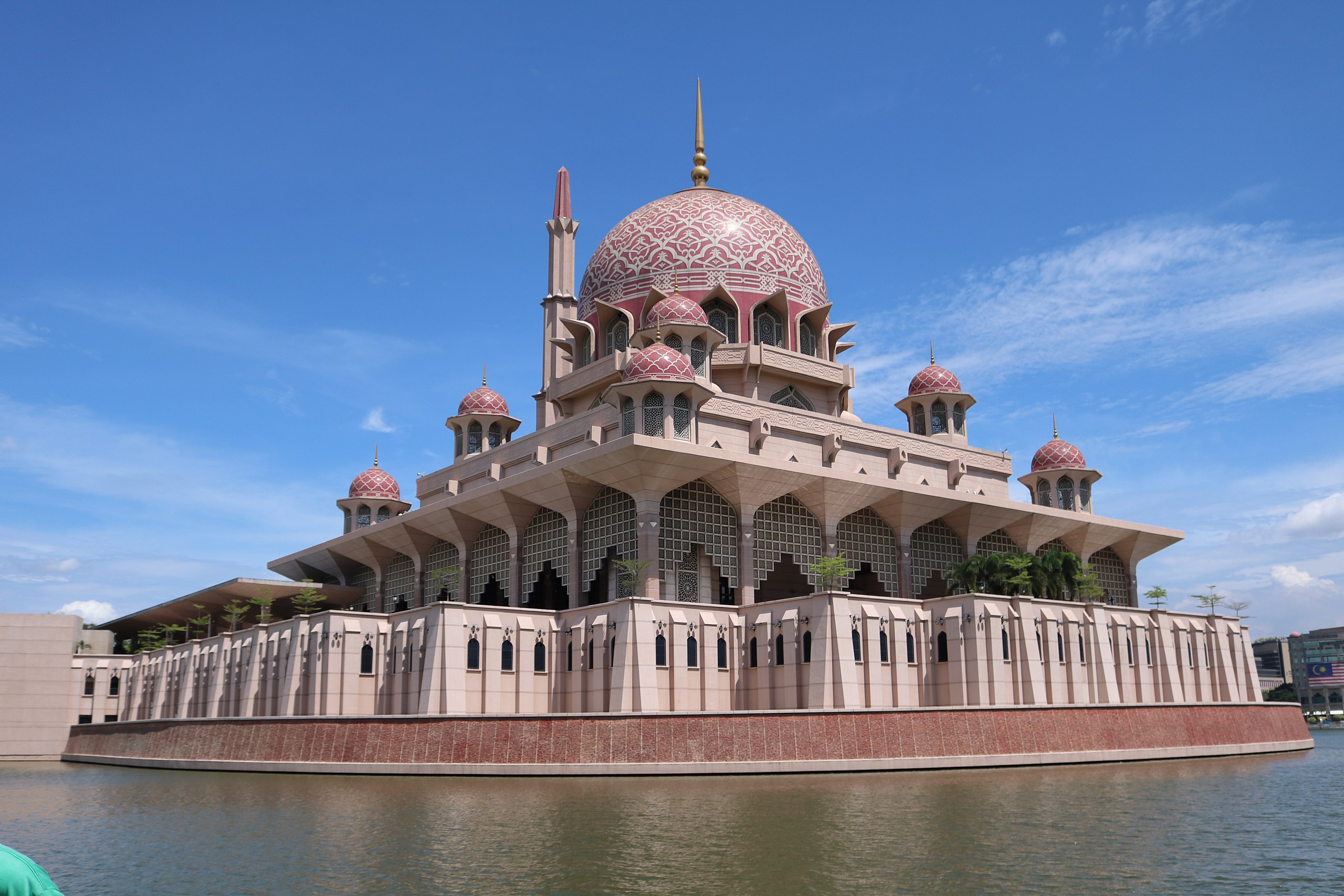
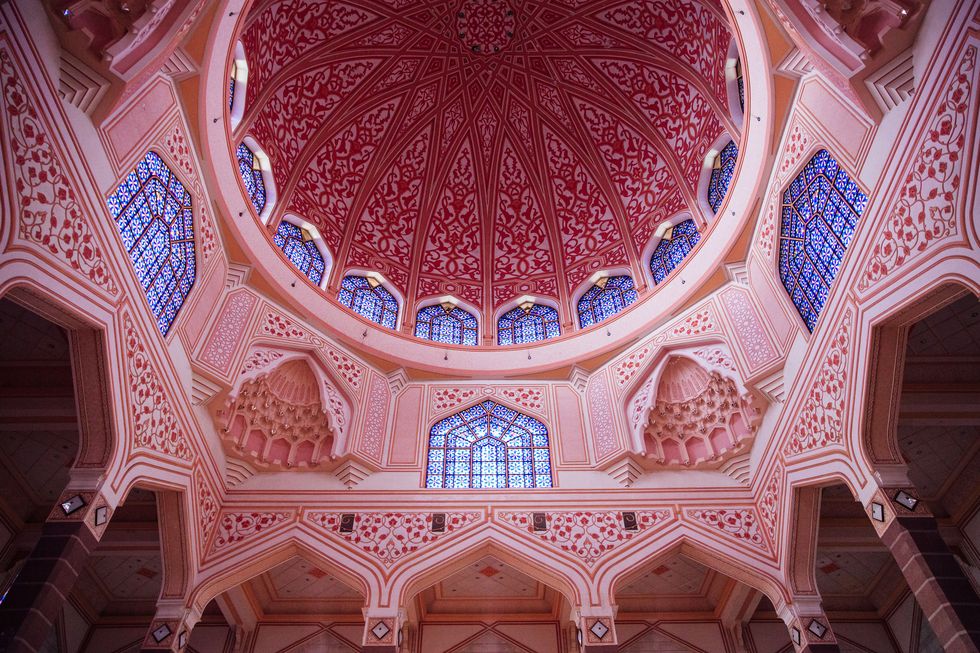
Putra Mosque in Putrajaya, Malaysia – On the banks of the Putrajaya Lake, the Putra Mosque combines Persian design elements with indigenous materials to create a distinctive Malaysian landmark. Constructed of rose-tinted granite, the mosque consists of the main prayer hall, the courtyard, and various function rooms, accommodating upward of 15,000 people.
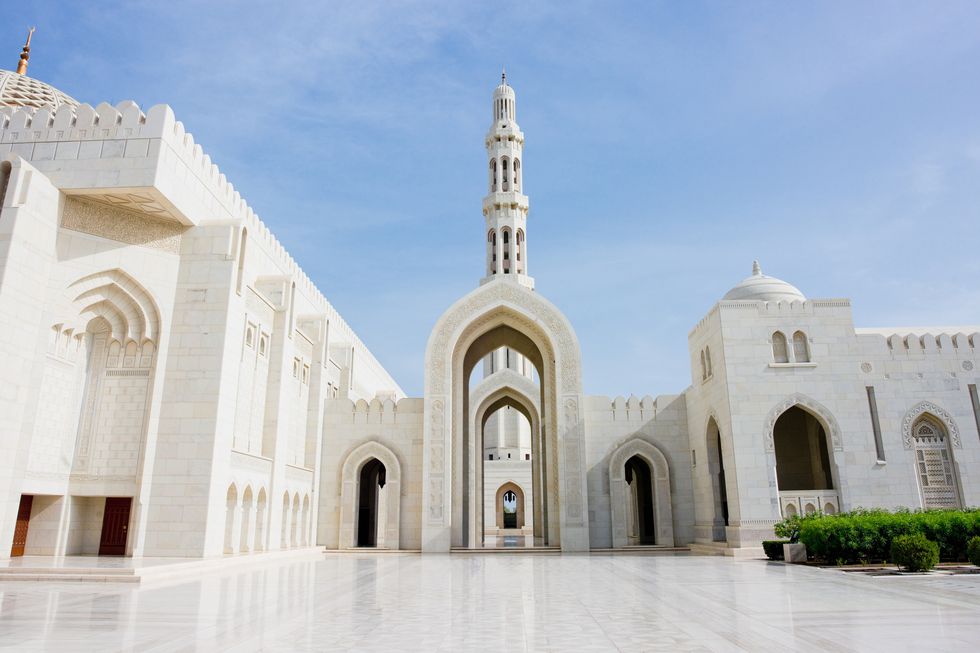
Sultan Qaboos Grand Mosque in Muscat, Oman – Sultan Qaboos announced his intention to build a palatial sanctuary in 1992, which included holding a competition to decide its design. After several years of construction, the Grand Mosque was finally inaugurated in 2001 as a way to celebrate the Sultan’s 30th year as ruler. The landmark’s showstopping centerpiece is the lavish chandelier over the men’s prayer hall; the lighting fixture consists of 600,000 pieces of crystal trimmed with gold and more than 100 lamps.
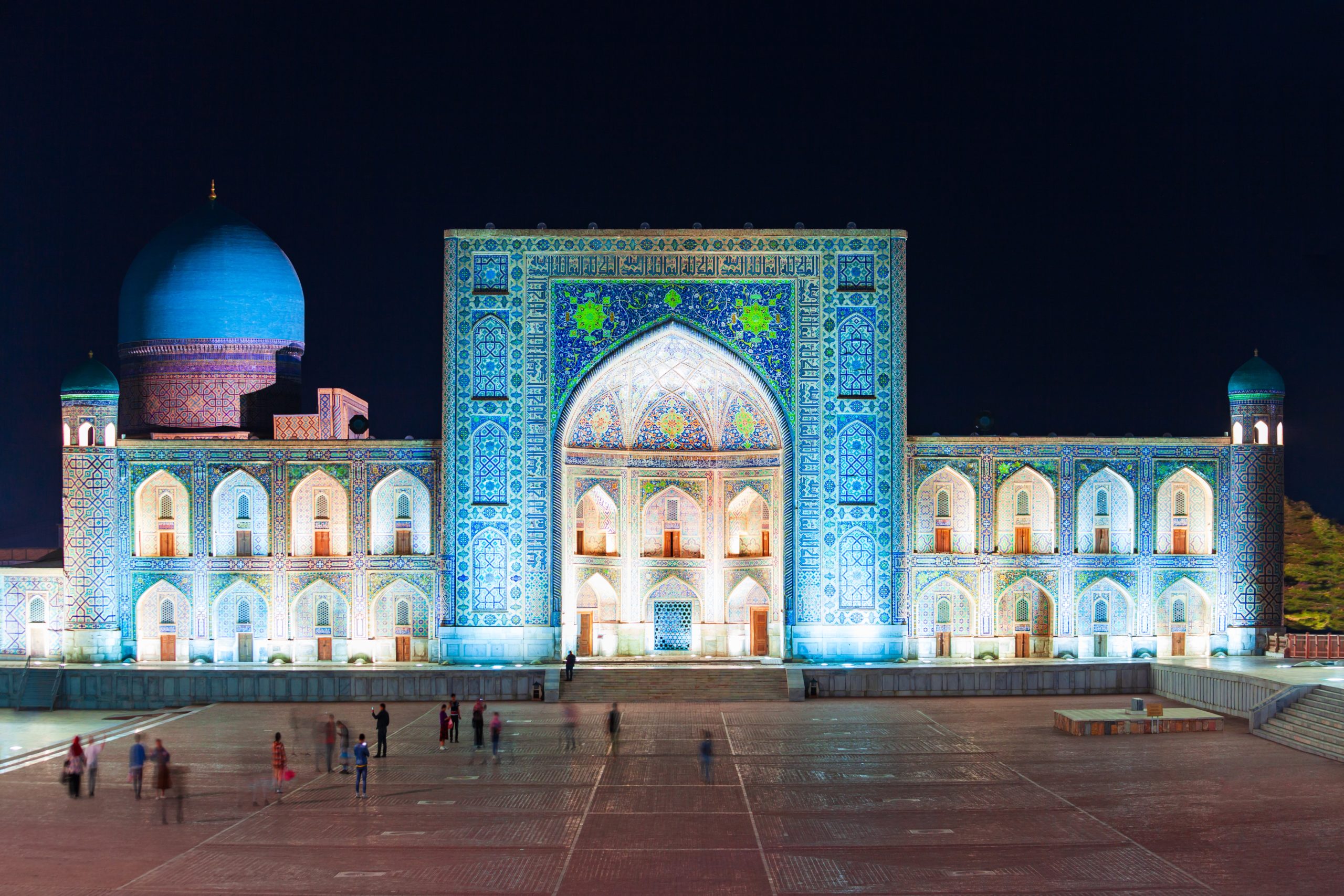
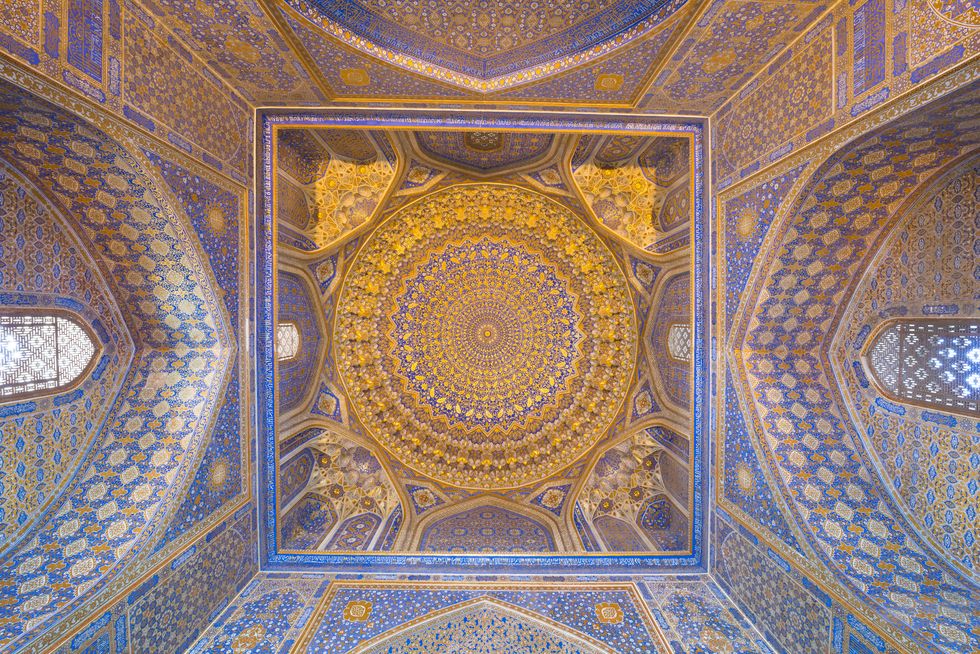
Tilla Kari Madrasa and Mosque in Samarkand, Uzbekistan – At the heart of the ancient city of Samarkand, the Tilla-Kari Madrasa and Mosque shines against its desert background with its breathtaking blue mosaics and gold-leafed cupola. Completed in 1660, the mosque’s luxe color palette symbolized the Silk Road city’s wealth during that era.
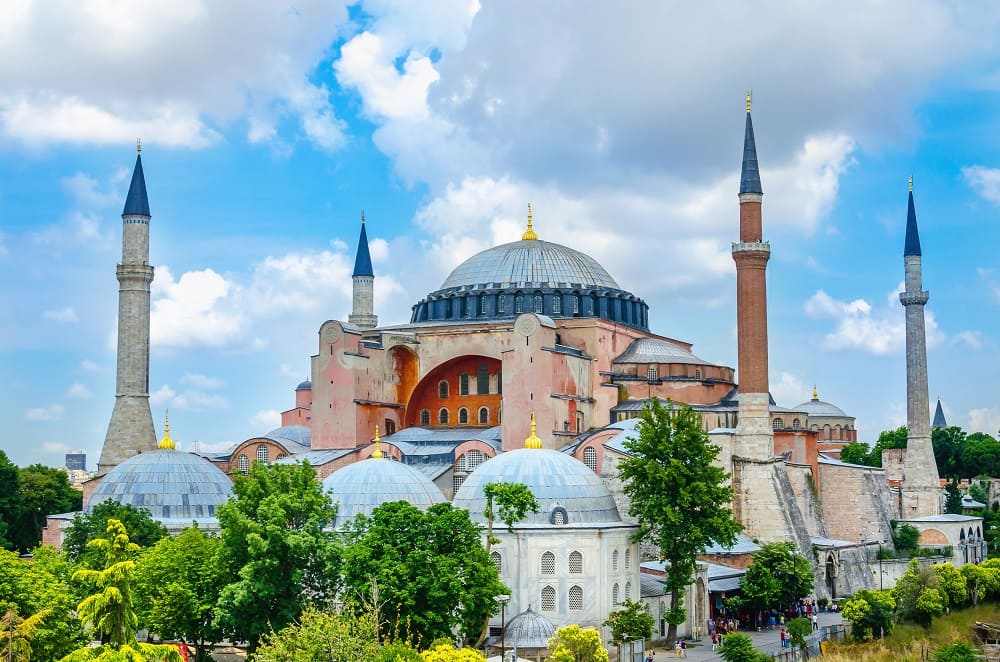
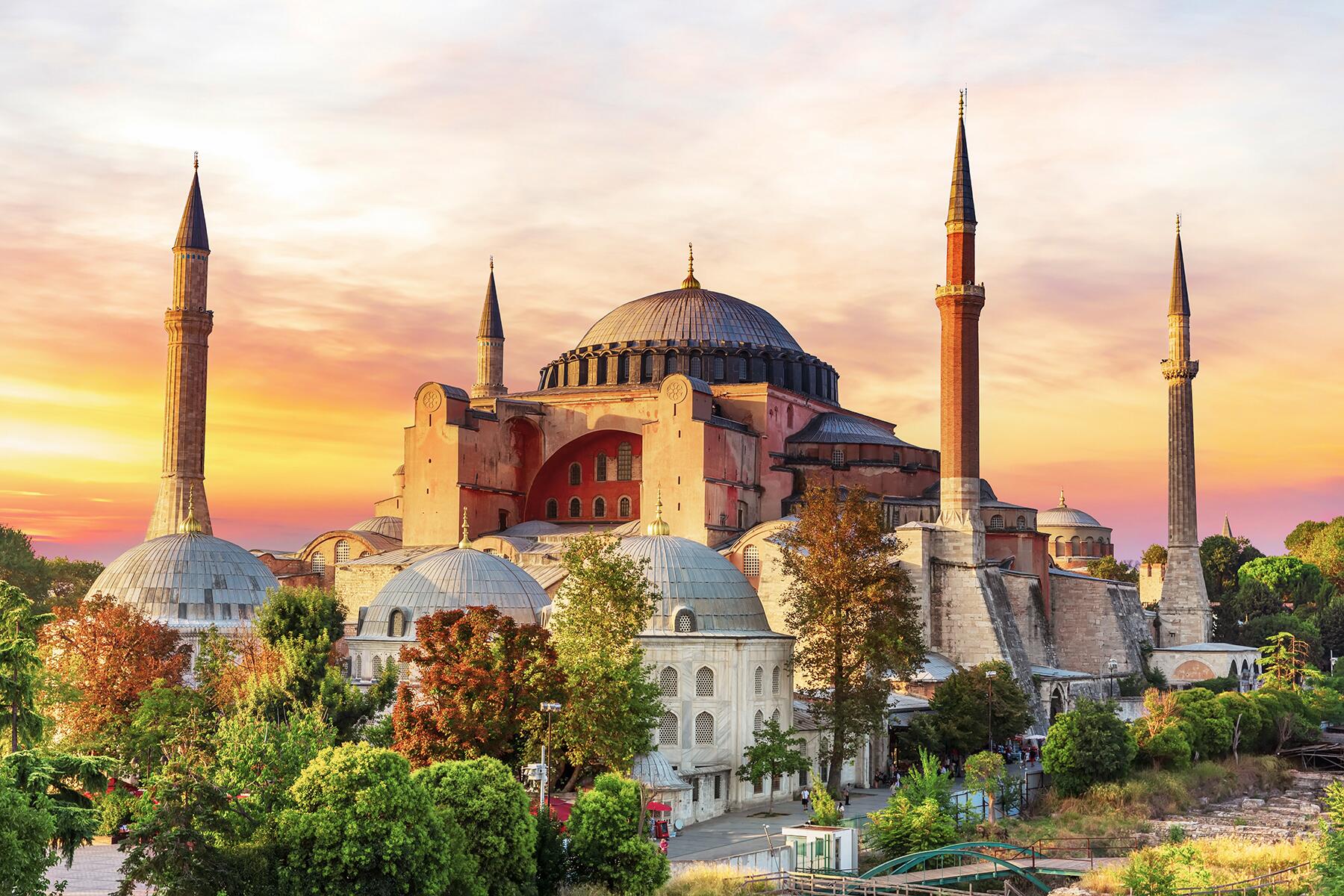
Hagia Sophia Mosque in Istanbul, Turkey – A symbol of Istanbul and one of the world’s most unique buildings, the Hagia Sofia has been through a number of changes during its 1,500-year history. A great surviving example of Byzantine architecture, the mosque was a Christian church in the Empire for almost 1,000 years before becoming a mosque under the auspices of the Ottoman Empire between 1453 and 1935.
Following a long stint as a museum, it was controversially converted back into a mosque in 2020 by Turkish President Recep Tayyip Erdoğan. But whether you agree with his decision or not, the beauty and architecture of the Hagia Sofia are beyond question.
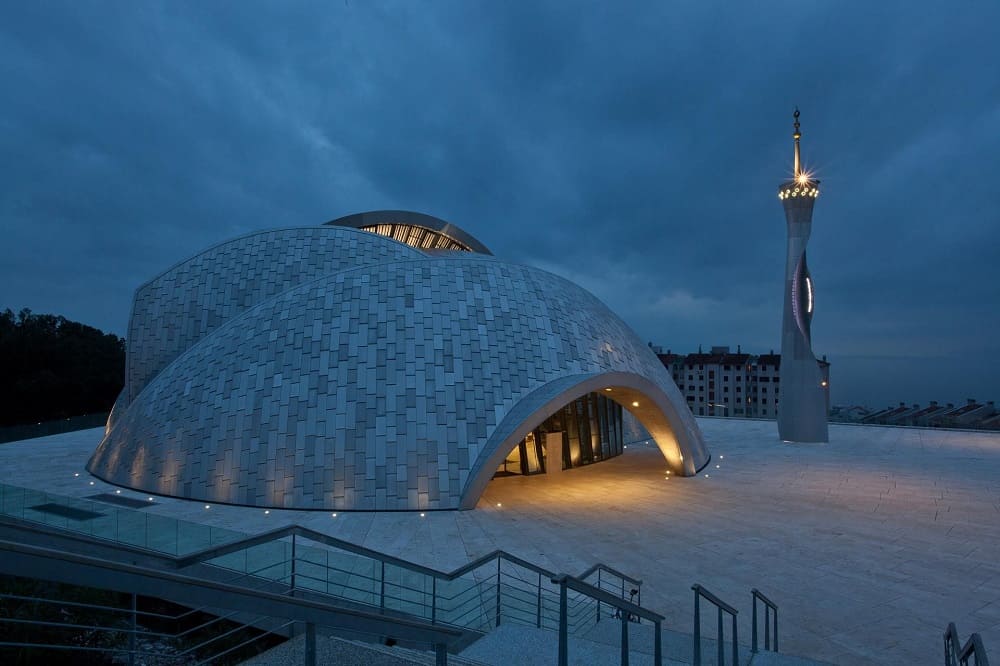
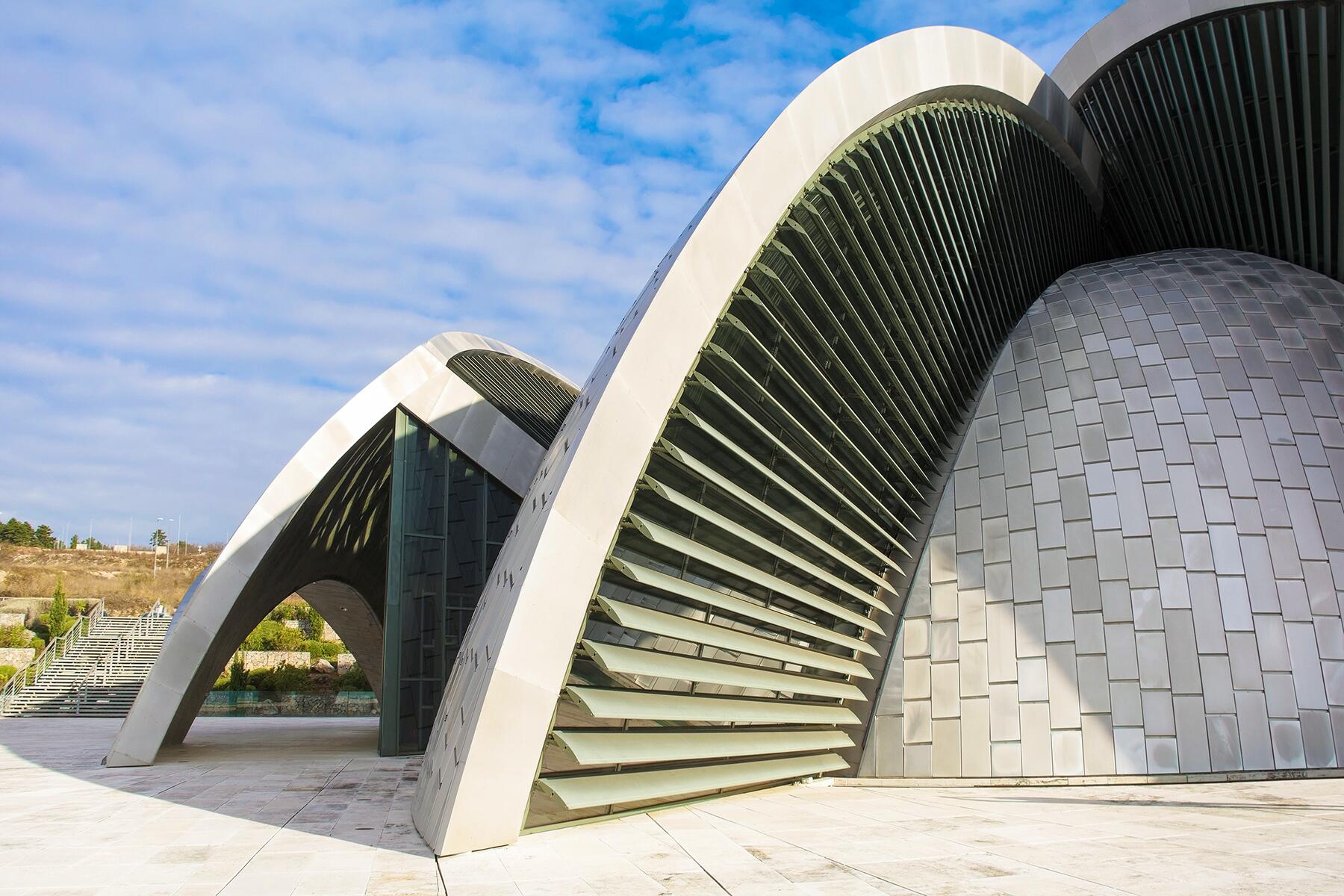
Islamic Centre Mosque in Rijeka, Croatia – This mosque is a beautiful amalgamation of contemporary and traditional Islamic art. Featuring curved geometric shapes and patterns, the mosque has a uniquely styled dome, shaped in five separate parts that visually make a single object. The Islamic Centre Mosque was designed by the well-known Croatian sculptor, Dušan Džamonja. A popular tourist site today, the mosque was built as a result of years-old aspiration of the Islamic community of Rijeka to have a dedicated space for offering prayers.
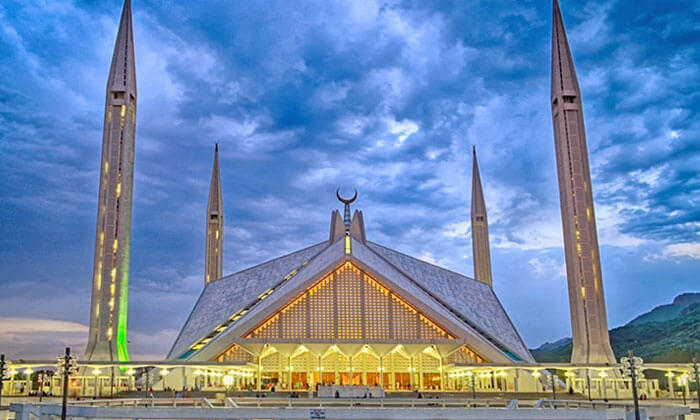
Shah Faisal Mosque, Islamabad – Situated on the foothills of Margalla Hills in Islamabad, Faisal Mosque is the beautiful mosque in southern Asia and the fourth largest mosque in the world. This beautiful mosque features contemporary designs with four tall minarets of 260 feet and eight-sided shell shaped sloping roofs, a worship hall which can accommodate around 10,000 worshippers at a time. It is a famous mosque and referred as an influential feature of Islamic architecture in the World.
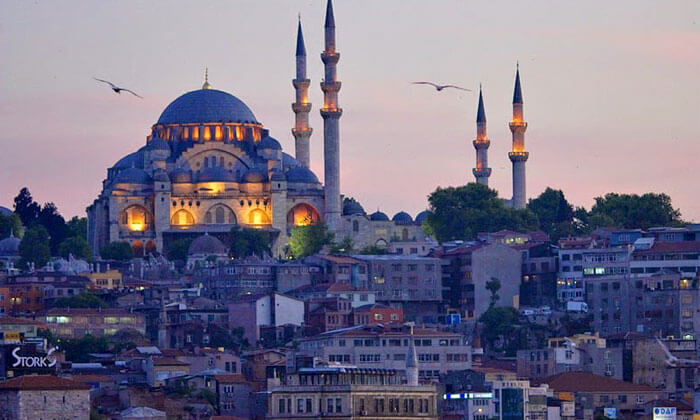
Suleymaniye Mosque, Istanbul Located on the Third Hill of Istanbul Turkey, Suleymaniye Mosque is the second largest and one of the most beautiful mosques in the world. The exterior of the mosque is of exceptional grandeur with the use of marble, granite and porphyry. Whereas the interior decoration is subtle with a very controlled use of Iznik Tiles, white marble, ivory and pearl. The design of the mosque features the perfect amalgamation of Islamic and Byzantine architecture which looks simply breathtaking in its structure and eye pleasing from inside.
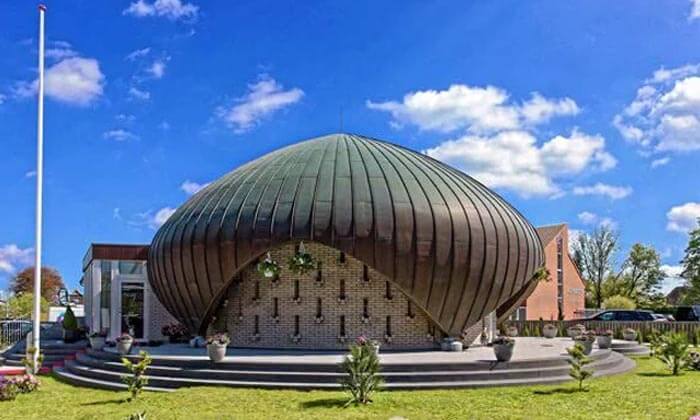
Nusrat Djahan Mosque, Copenhagen uilt-in Denmark in the year 1967, The Nusrat DJahan Mosque is one of the most beautiful mosques in the world, solely financed by the females of the Ahmadiyya Community. It is the very first mosque built in Denmark and promises you the perfect spiritual surrounding to pay homage to the almighty. The architecture of the mosque is mesmerizing and attracts number of people from all over the world.
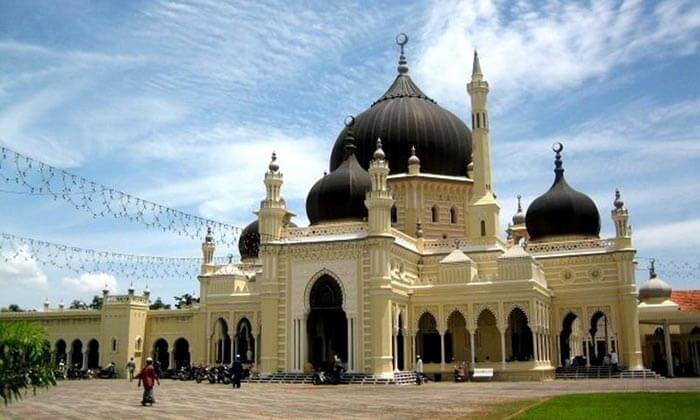
Zahir Mosque, Malaysia – Situated in the capita of Kedah, The famous Zahir Mosque is one of the oldest mosques in Malaysia. Constructed in the year 1912, the mosque has been very famous and voted as one of the top 10 most beautiful mosques in the world. The beauty comes from the design which is inspired by the Azizi Mosque of the Langkat Sultanate in North Sumatra. There is a state’s Quran reading competition which is organized every year within the premises of the mosque. Zahir mosque stands as an elegant example of Malay-Islamic architecture with its beautiful walls and ceilings and attracts large number of travelers from all across the globe.
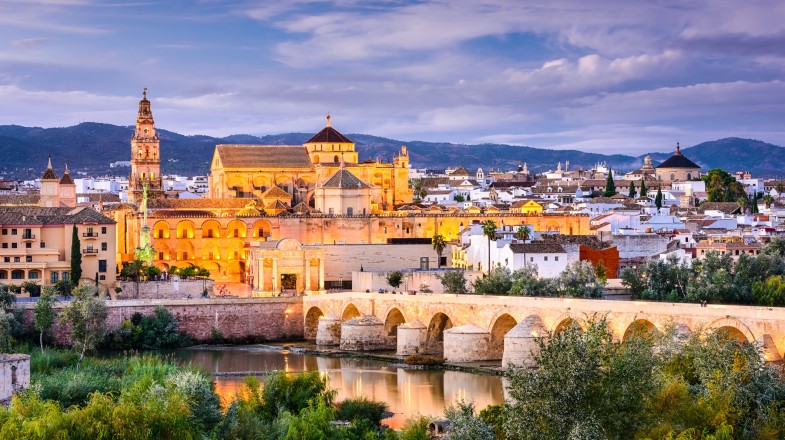
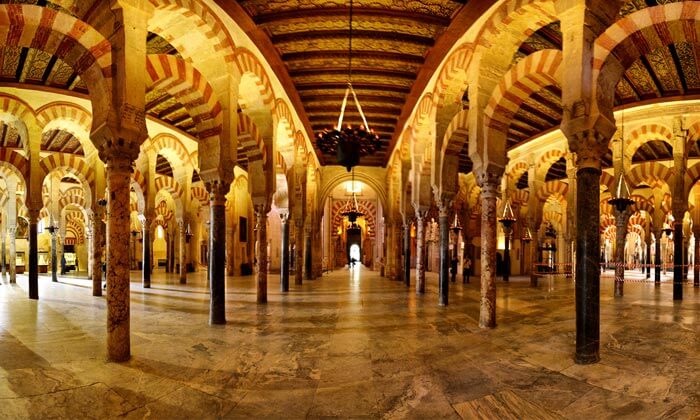
The Great Mosque of Cordoba, Spain – Sited in Spain, The Great Mosque of Cordoba is one of the most beautiful mosques. Known locally as Mezquita-Catedral, the Great Mosque of Cordoba is one of the oldest structures standing from the late 8th century. Unlike other mosque which got torn down, during the time when Christian conquered Cordoba in 1236; this was the only mosque that survived to become the main tourists’ attractions of Spain. The building of the Mosque represents the true architectural splendor with its decorative walls and the use of red and white bricks. In whole of the structure there are no paintings, sculpture or chairs, just the geometrical patterns inscribed out of the pillars creating the serene environment to pray. The most exceptional trait of the building is its arcaded hypostyle hall, with 856 columns of jasper, onyx, marble, and granite.
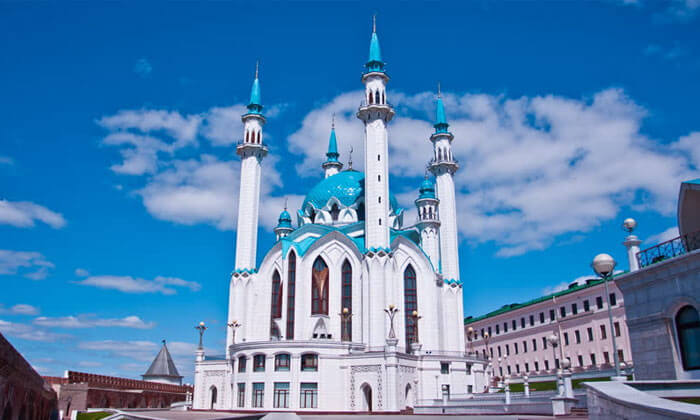
Qolsharif Mosque, Russia – Originally constructed in 16th century, Qolsarif Mosque is one of the largest mosques in Russia and in the Europe. The mosque got damaged during the attack of Kazan and constructed again during 1996. Currently the mosque primarily serves as a museum of Islam and at the same time an ideal place during the major Muslim celebrations. The structure of this beautiful mosque is more like a Disney castle and attracts large number of travelers from all over the world. Representing as a true architectural marvel, the mosque houses a publishing house, one Imam’s office and a library.
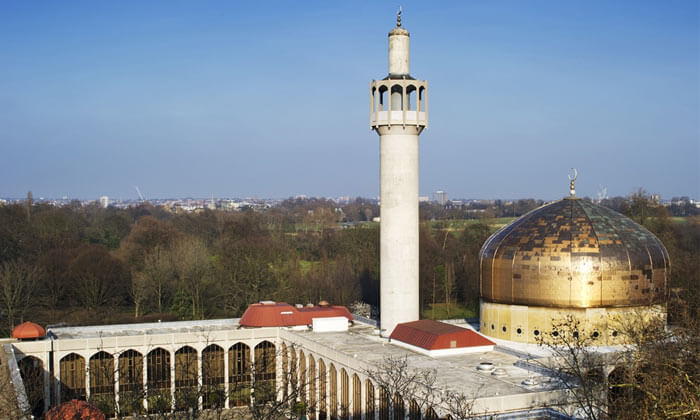
The London Central Mosque, London – Designed by Sir Frederick Gibberd in 1978, the London Central Mosque is a popular spiritual place and tourist attraction in London. The structure of the mosque is remarkably well established with the interiors having a chandelier, a vast carpet, broken shapes in the Islamic tradition, a small bookshop, a halal café on its premises and a most prominent golden dome. Situated near the Regent’s Park in London, the mosque can accommodate over 5, 000 worshippers at single time along with a separate balcony for female worshippers.
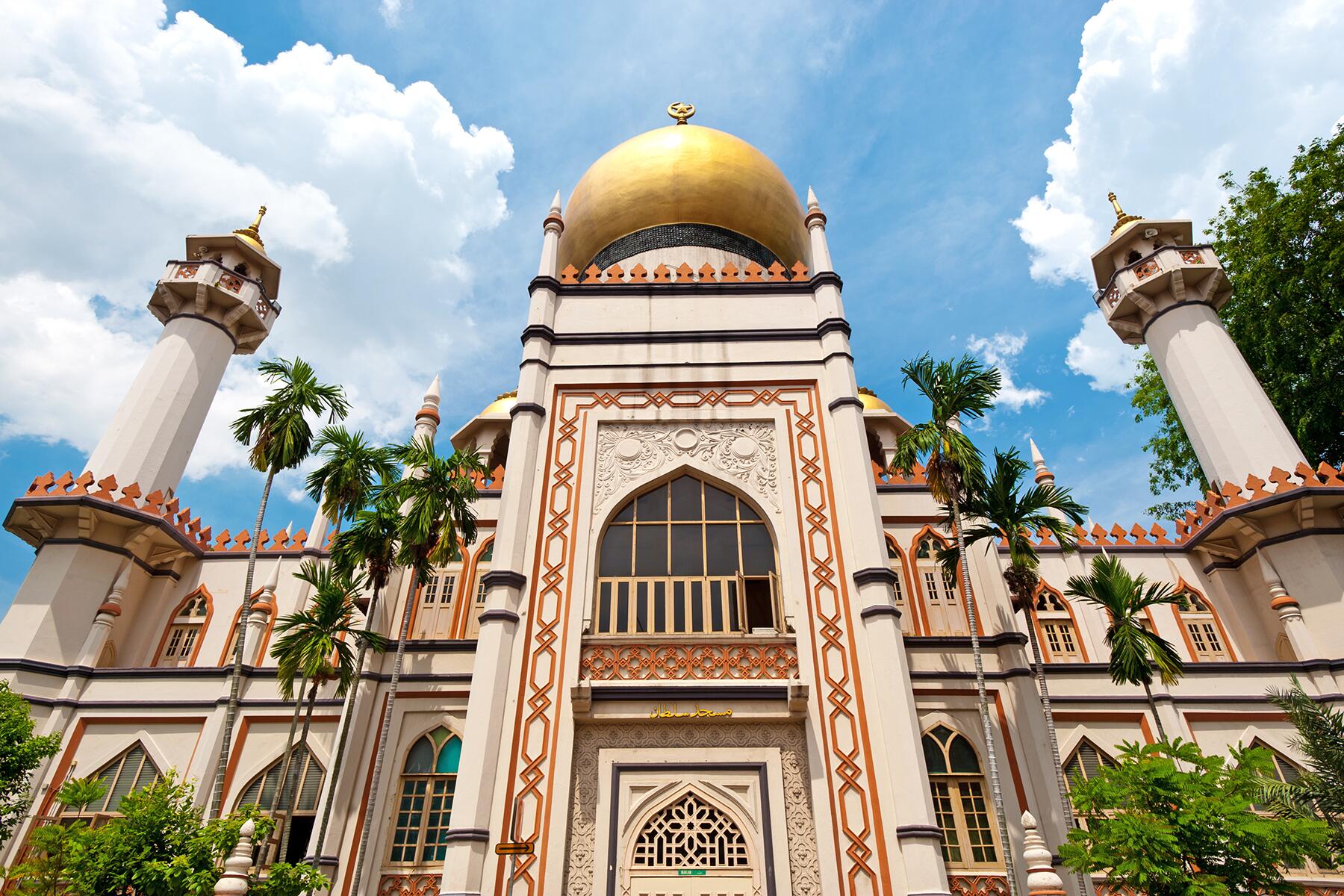
Sultan Mosque or Masjid Sultan is a mosque located at Muscat Street and North Bridge Road within the Kampong Glam precinct of the district of Rochor in Singapore. It was named after Sultan Hussain Shah. In 1975, it was designated a national monument.
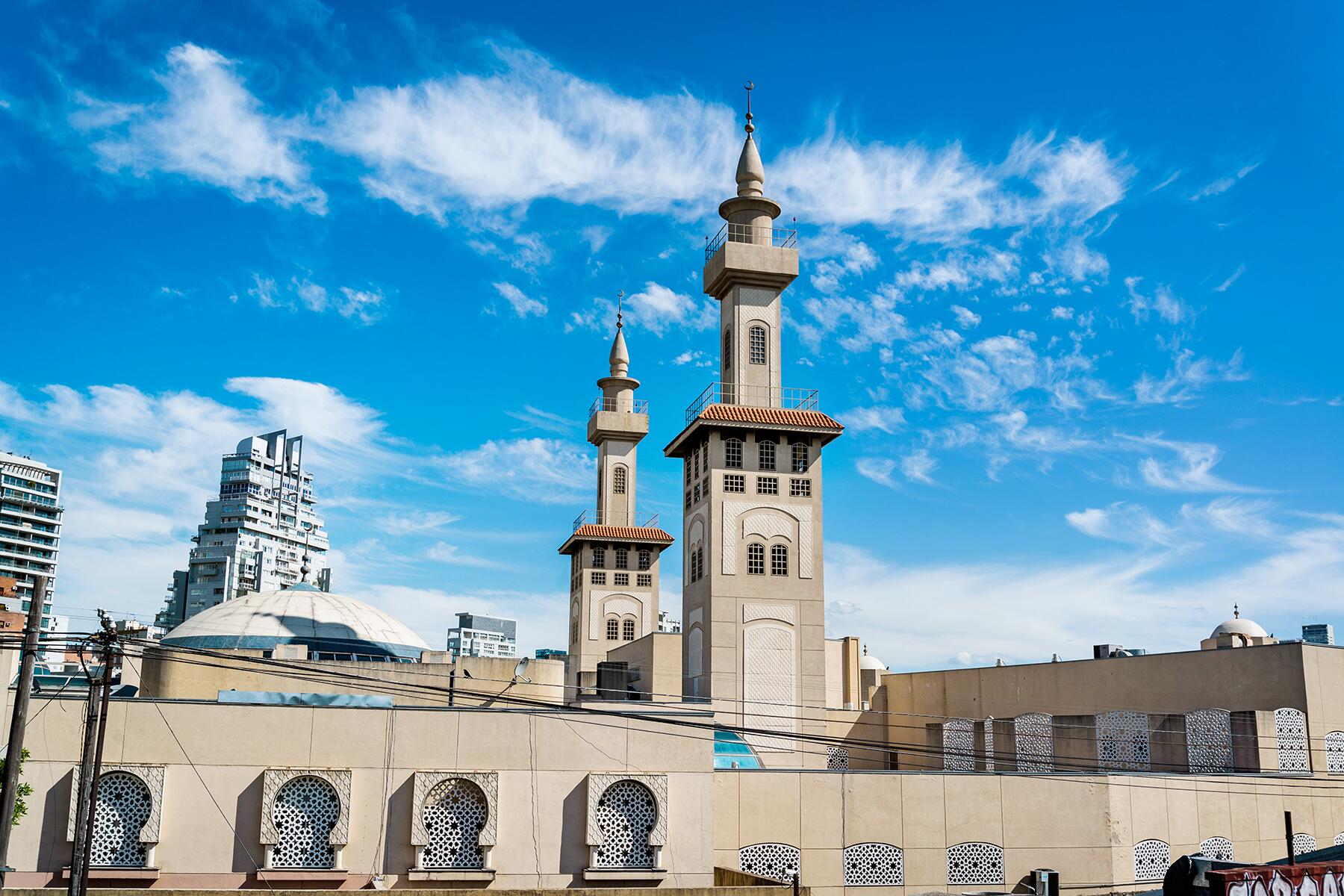
King Fahd Islamic Cultural Center – Completed in 2000 and designed by Saudi architect Zuhair Faiz, the King Fahd Islamic Cultural Center in the Palermo district of Buenos Aires is the largest mosque in Latin America. Taking its name from the late King Fahd of Saudi Arabia, it began life as a result of a state visit to the country by Argentinian President Carlos Menem in 1995. The enormous 34,000-square-meter site contains a prayer hall with capacities for 1,200 men and 400 women as well as an Islamic school and a library.
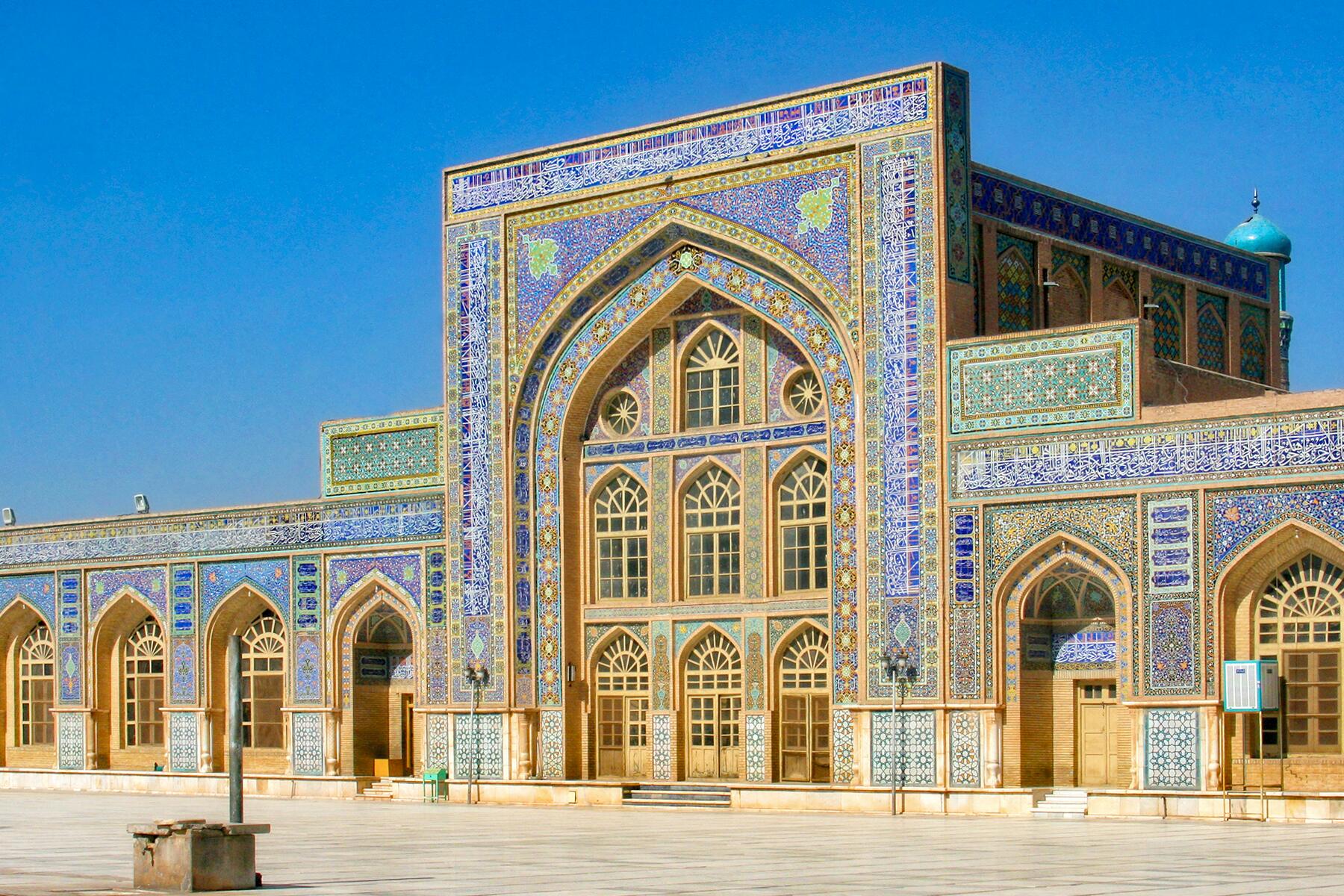
Great Mosque of Herat, Afghanistan – On first approaching the Great Mosque of Herat, visitors will be struck by the ornate, tiled façade with a huge arch flanked on either side by two soaring minarets wrapped in stunning geometric patterns. At least 600 years old and going through various incarnations, this stunning mosque is easily the grandest in Afghanistan and one of the finest in all of Asia. The extravagant tiling that now covers the mosque is the result of its own tile workshop, an ongoing restoration project since the 1940s.
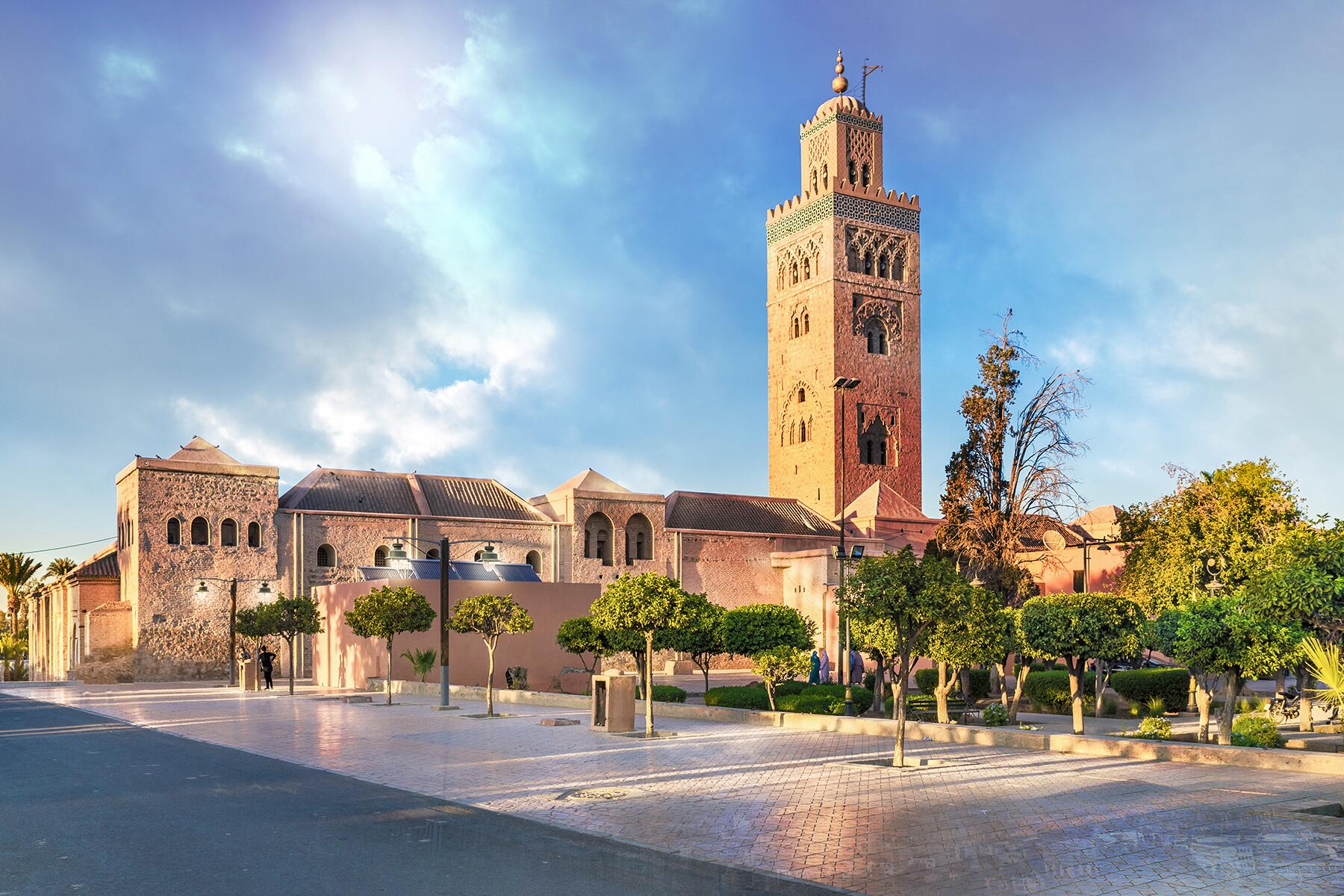
Koutoubia Mosque, Marrakesh, Morocco – Dominated by its enormous 250-foot minaret, Marrakesh’s Koutoubia Mosque is a city icon to the point where local laws restrict any new building projects from exceeding the height of the minaret. Constructed around 1158 under the Almohad dynasty, the mosque is a fine example of Moorish architecture and remains the largest mosque in Marrakesh. Thanks to an old Moroccan technique, the minaret’s bright brass spire shines year-round as every year its spheres are filled with mineral-rich salt from the High Atlas, to keep the spire from oxidizing.
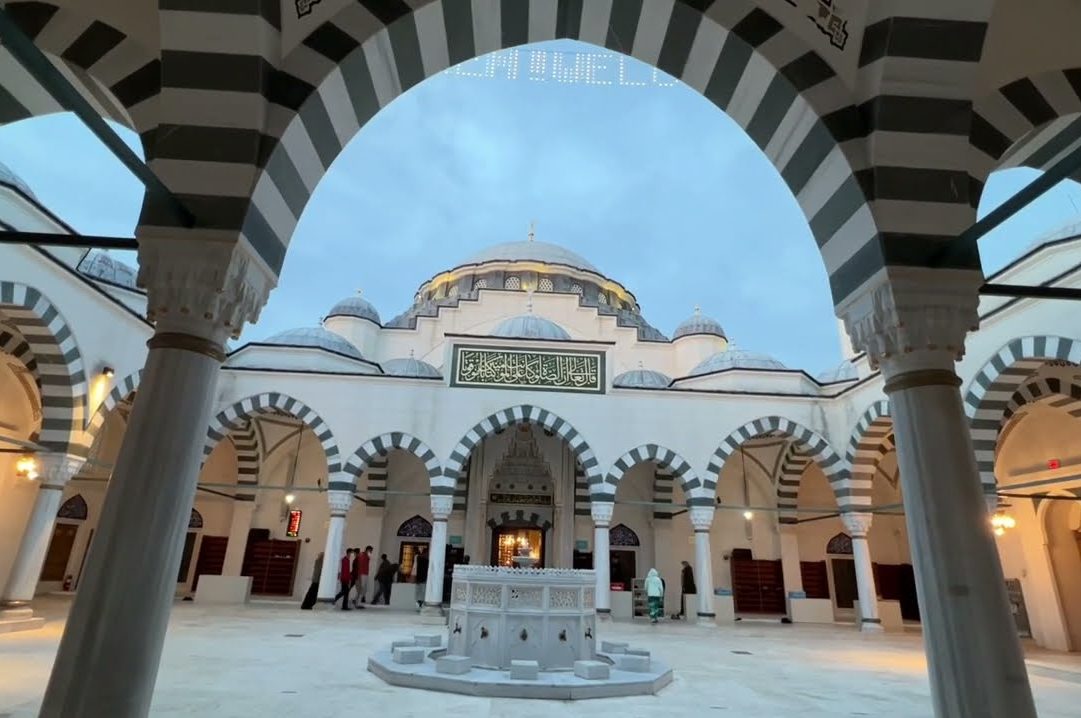
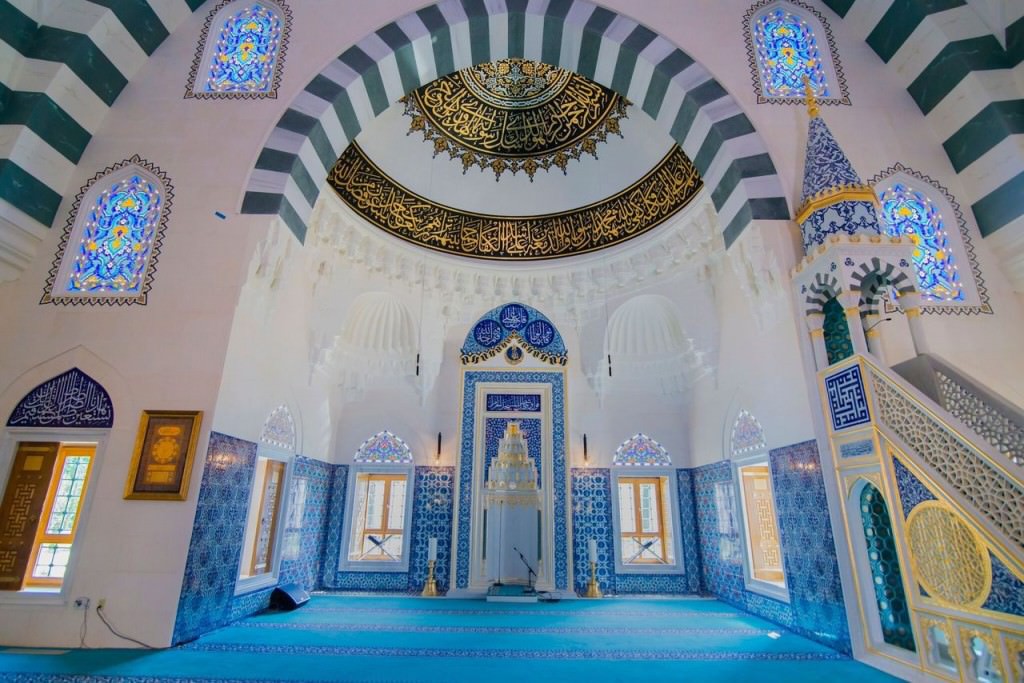
Diyanet Center of America, Maryland, USA – Built in classic 16th-century Ottoman style, the Diyanet Center of America is a striking piece of Islamic architecture in an otherwise unremarkable neighborhood of Lanham, Maryland. Completed in 2015, it largely serves the Muslim community of the Washington Metropolitan area and covers over 20,000 square feet. Much like the King Fahd Islamic Cultural Center in Buenos Aires, it functions as a learning complex with a guest house, a fellowship hall, and a recreational building.
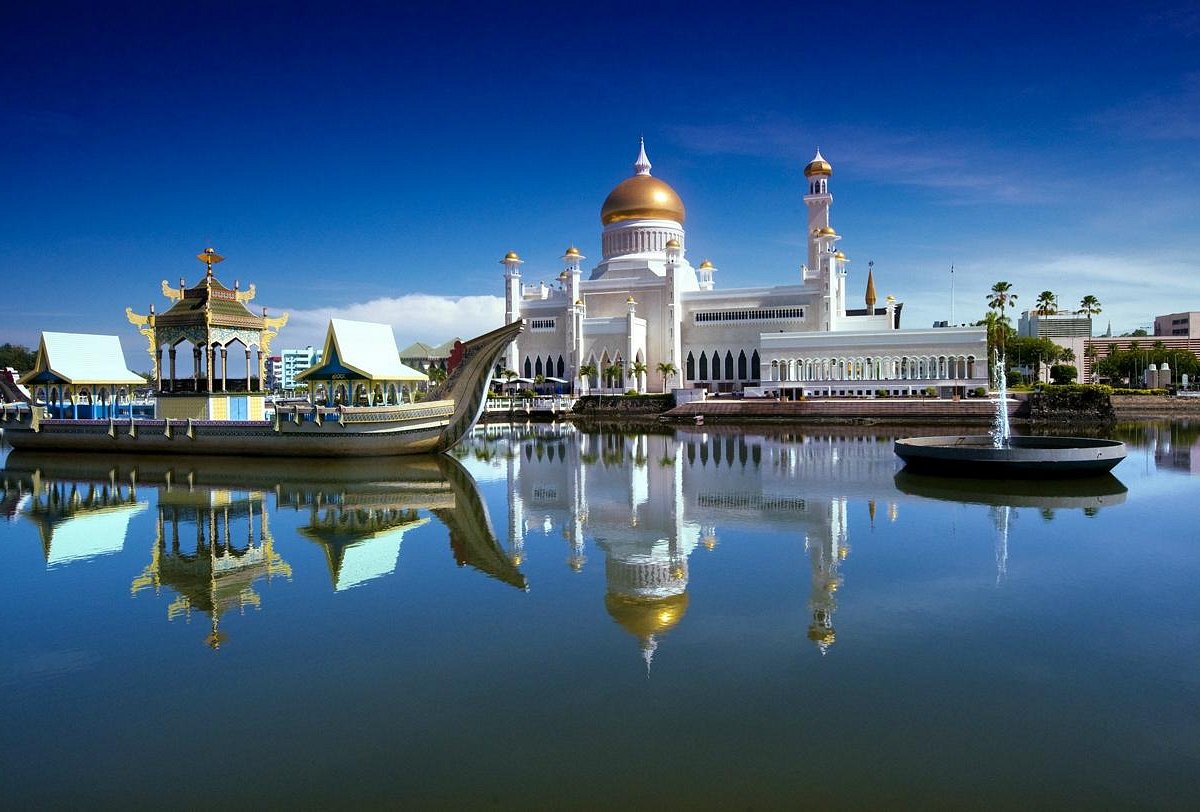
Sultan Omar Ali Saifuddien Mosque, Brunei – Located in Bandar Sri Begawan, the capital of Brunei Darussalam, it is widely regarded as one of the most beautiful mosques in South East Asia. Besides being a place of worship, it is also a major historical site and a famous tourist attraction. Visitors of Brunei would not want to miss this structure as it dominates the skyline with one of its minarets being the tallest building in Bandar Sri Begawan. Apparently, the Sultan ordered the top storey of a nearby building to be removed, in order for it to not exceed the minaret’s height. It also features a ceremonial stone boat in the lagoon, which is based on a 16th-century royal barge!

Jami-Ul-Alfar Mosque, Colombo, Sri Lanka – With the blue mosque in Istanbul, there’s also a red mosque in Colombo. In one of the busier commercial districts of Colombo – Pettah, stands this striking and unique structure. Each brick used in the construction of this outstanding piece of architecture is painted red or white and used in contrasting designs – hence, it’s commonly known as the Red Mosque. Its Indo-Saracenic architecture, featuring pomegranate-shaped domes gives this mosque its own character, Some also claim that this building was used as the landmark of Colombo by sailors approaching the port in the past.
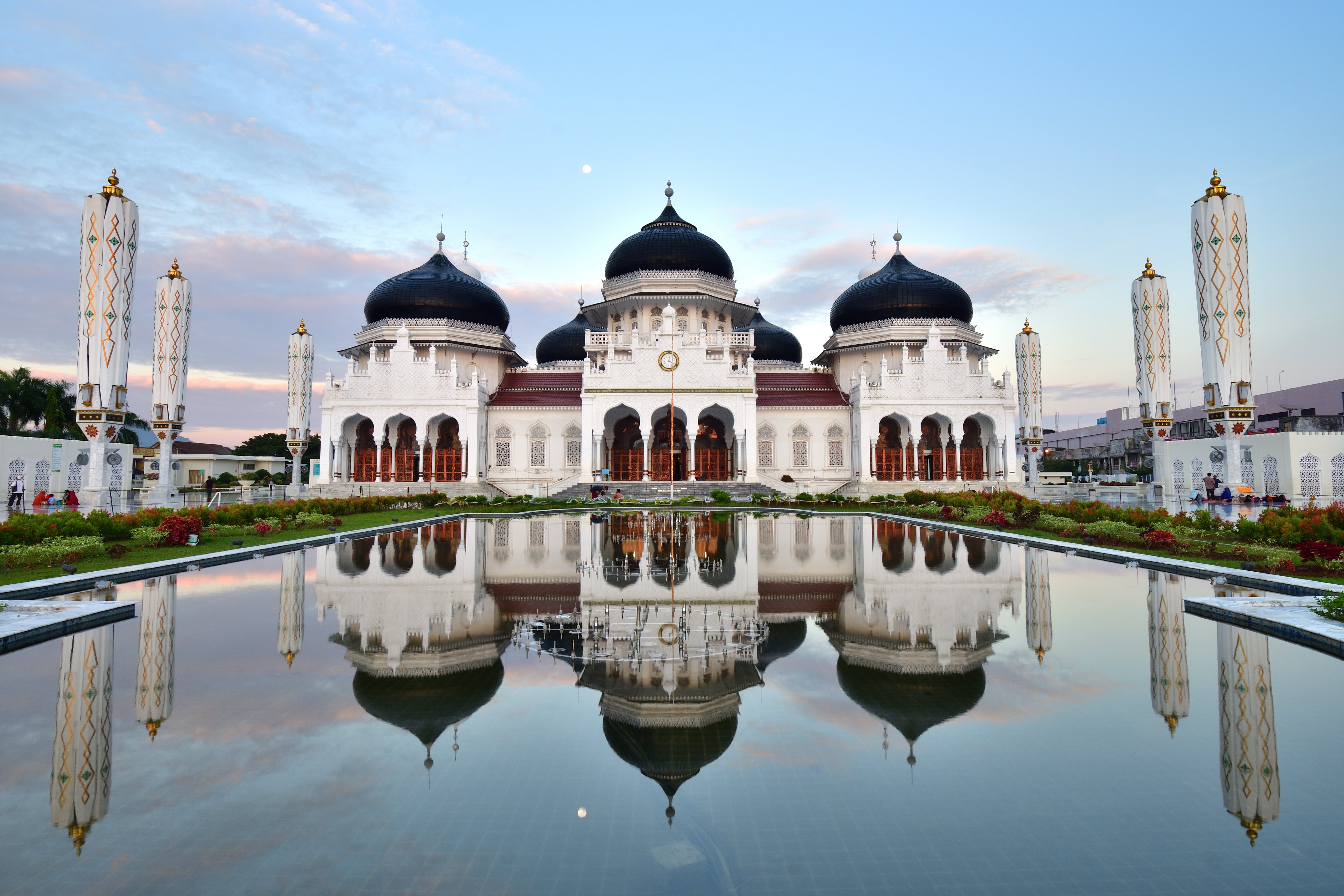
Baiturrahman Grand Mosque, Banda Aceh, Indonesia – Displaying unique black domes, made of hardwood shingles combined as tiles, this mosque is one of the better-known mosques in Indonesia due to its significance during the 2004 tsunami. Many cited divine intervention as the reason this 130-year-old mosque somehow survived and withstood the disaster when neighbouring structures around the mosque were flattened by the unstoppable swell. Numerous locals took refuge here while the tsunami ravaged the landscape of Banda Aceh. Images of the incident still mesmerise many even to this day. With its design based on the Mughal revival style, today it features 7 domes, 8 minarets and 32 pillars.
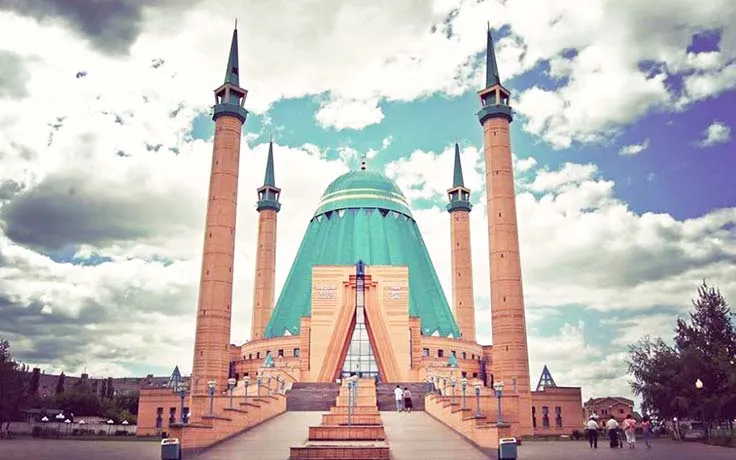
Mashkhur Jusup Central Mosque, Pavlodar, Kazakhstan – Adorned with an 8-axis star, a dome and 4 minarets, this mosque can be found right in the city centre. Being true to its function as a proper mosque, it also features a school, wedding hall, library, cinema, dining room and also an Islamic culture museum among others. Built primarily from monolithic iron concrete, bricks, metal, marble and aluminum, its architecture became an inspiration and has influenced many urban designs in the country. Certainly, its centerpiece is unique and cannot be found anywhere else in the world.
